

At 3 am
Anil Agarwal, founder of Centre for Science and Environment (CSE), and founder editor of Down To Earth, was in Bhopal immediately after the tragedy. This piece captures the state of affairs 15 days into the tragedy An epic tragedy and tales of valour and follies
Ashay Chitre, a filmmaker living in Bhopal’s prestigious Bharat Bhawan, built by the state government to attract artists to this central Indian city, heard a commotion outside his window early in the morning at about 3. It was a chilly December and all the windows of Chitre’s house were closed. As Chitre and his wife Rohini, seven months pregnant, opened the window, they got a whiff of gas. They immediately felt breathless and their eyes and nose began to stream with a yellow fluid. Sensing danger, the couple grabbed a bed sheet and ran out of the house. Unknown to them, all the neighbouring bungalows, which had telephones, had already been evacuated.
Their immediate neighbour, state labour minister Shamsunder Patidar had fled. The chief minister, who lives only 300 m from the Chitres had probably also been informed in time. Outside their house the Chitres found chaos. There was gas everywhere and people were running for their lives in every direction, with nobody to tell them the safe way out. Some fell vomiting and died. The panic was so great that people left their children behind, or did not stop to pick up those overcome by exhaustion or the gas. At one place, the couple saw a family stop running and sit down.
See also: 30 years of Bhopal gas tragedy: A continuing disaster
"We will die together", they said. Another person ran for 15 km in a desperate bid to escape. A passing police van had no clue to the safe direction. Stepping over bodies, the Chitres ran towards the local polytechnic, half-a-kilometre away, where they stopped and decided not to go further. Two hours later, at about 5 am a police van arrived announcing that it was safe to go back home. But nobody believed the policemen.
From the polytechnic, the Chitres rang friends on the other side of the town for help. They returned home three days later. Their pomegranate tree had turned yellow and the peepul tree, black. Three days after that fateful night, Rohini began to experience pain whenever she exercised and Ashay felt his legs buckle. They immediately left for Bombay (Mumbai now) to see a neurologist to ascertain their fate and that of their unborn child.
Mass panic
There were thousands of others that night in Bhopal for whom this macabre drama began much earlier and who were a lot less lucky than the Chitres. Most of them were
the city’s poor, living in the sprawling settlements opposite and around the Union Carbide factory. One of them is Ramnarayan Jadav, a driver of the city corporation,
who says that he had started sensing the gas around 11.30 pm itself. But he stayed on for at least another 45 minutes because “this much gas used to leak every eighth
day and we used to feel irritation in the chest and in the eyes. But finally everything used to calm down.” Even if the company had set off its warning siren then, many
could have escaped.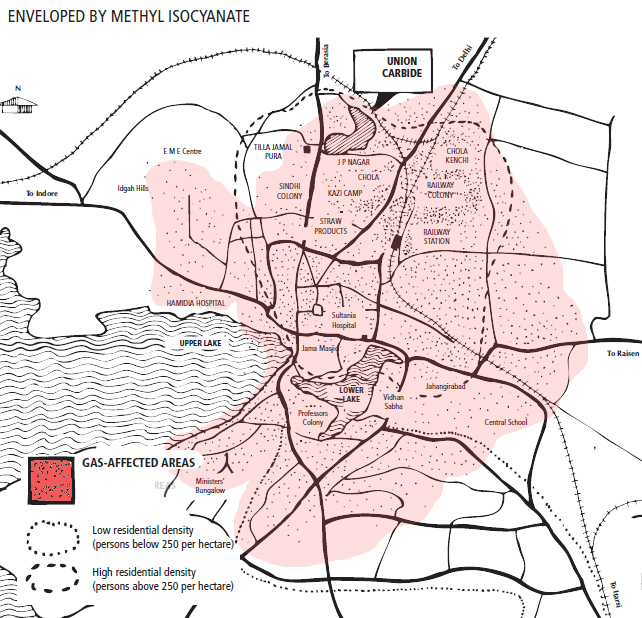
The gas that spewed out of the hi-tech factory of the multinational Union Carbide spread over some 40 sq km and affected people seriously as distant as
five km to eight km downwind. For nearly 200,000 people, a quarter of the city’s population, Bhopal became a gas chamber. If it were not for the two lakes of
Bhopal which came in the way of the gas cloud and neutralised it, an even bigger tragedy could have taken place.
To hospital to die
At Bhopal’s 1,200-bed
Hamidia Hospital, the first patient with eye trouble reported at 1.15 am. Within five minutes, there were a thousand and by 2.30 am there were 4,000, suffering from not
just eye ailments but also from respiratory problems.
On the intervening night of December 2-3, 1984, methyl isocyanate gas leaking from Union Carbide’s factory in Bhopal claimed more than 5,000 lives. More than half a million people still suffer the side effects of the exposure to the gas; the soil and groundwater have been contaminated and toxicity has crossed over to the second and third generations.
By about 1 am, about 25,000 people were crammed into Hamidia Hospital. The
floor was splattered with blood and vomit. Said a doctor at Hamidia, I saw at least 50 bodies taken away like this. I would
estimate that anything between 500 and 1,000 bodies were taken away before their deaths could be registered.” It was difficult for survivors to identify their dead.
Death drama
At the Hindu cremation ground, about 15 pyres were lit at a time, starting at 9 am. The crematoriums soon ran out of firewood and trucks had to be marshaled to bring in more. To save time, money, energy and humanpower, five to 10 persons were cremated on each pyre. At the Muslim burial ground, too, there was not enough space to bury the bodies coming in. Rescue workers dug graves each holding 11 bodies. The death drama continued for days.
Everywhere one turned, people were retching, racked by violent coughing. All the shops in the city were closed, and on every street people were lying in the gutters. They were dead,
dumped in agonised frozen postures, like birds shot from the sky. In their midst were real birds—vultures. When the vultures swooped away, the
dogs would charge in and tear off pieces of flesh.
A short history of Union Carbide
 Union Carbide is the third largest chemical company and 37th largest industrial corporation in the US. It owns 700 chemical
plants, mines, mills and other business operations in 37 countries. Union Carbide’s operations are extremely diverse. It has
been in the nuclear weapons game since the Manhattan Project of World War II, and is the sole contractor manufacturing enriched uranium and weapons components
for the US government.
Union Carbide is the third largest chemical company and 37th largest industrial corporation in the US. It owns 700 chemical
plants, mines, mills and other business operations in 37 countries. Union Carbide’s operations are extremely diverse. It has
been in the nuclear weapons game since the Manhattan Project of World War II, and is the sole contractor manufacturing enriched uranium and weapons components
for the US government.It also makes consumer products like Eveready batteries — it is the world’s largest producer of batteries — industrial gases, and molecular sieves for removing organic chemical pollutants from wastewater streams. Pesticides production is only a relatively small part of Carbide’s operations and not the most profitable one. Sales of agricultural products declined in 1983. Carbamate pesticides, manufactured from methy isocynate (MIC), account for most of Union Carbide’s agricultural products. All of Union Carbide’s operations have the potential of risk to health of workers and communities, and to the environment. When the tragedy at Bhopal happened, Union Carbide tried to picture it as a freak accident that has happened to a company with an otherwise exemplary record in environ mental and health matters. But this was not only untrue, Union Carbide had consistently fought any claims of damages caused by its operations. Vinyl chloride workers, for example, at Union Carbide’s South Charleston plant, were found in 1976 to have not only six cases of angiosarcoma, of the 63 found worldwide
A Union Carbide subsidiary was also responsible for the Gauley Bridge tunnel disaster in the early 1930s, regarded as one of the world’s worst industrial disasters. Construction of the tunnel began in 1930. Gauley Bridge tunnel workers began dying nine to 18 months after exposure to the dust. The company avoided autopsies and death certificates. A US official put the total at 476 dead and 1,500 disabled.
In the 1950s and early ’60s, processes were being developed to use mercury for the separation of lithium-3, a vital component of the hydrogen bomb. One-third or more of the known mercury in the world was bought up for Oak Ridge at this period. A huge quantity of it was lost: £2.4 million was unaccounted for. Some £475,000 was known to have been spilled into a creek. In 1983, Union Carbide’s secrecy cover in Oak Ridge was blown. Mercury at levels 35 times greater than allowed by the state was found in soil.
Union Carbide has also had problems with its major pesticide, Temik. Pure aldicarb is probably the most toxic pesticide manufactured today but it is claimed that it breaks down very rapidly. By 1983, Temik was being used in 38 US states and exported to 60 nations. But events in the early 1980s began to refute the assumption that Temik could not prove a human health hazard because of its rapid breakdown. Temik had been widely used in New York potato fields under Union Carbide assurances that it could not migrate into groundwater. In 1979, about 1,500 wells were found to be contaminated with Temik, at levels above the state’s safe limit for drinking water of seven parts per billion.
Union Carbide has been particularly lax about health and environmental safety in the Third World. It has been operating several plants in Puerto Rico since 1959. Neighbours of at least one of Union Carbide’s operations have been complaining about the ill-effects of air pollution created by the plant. In Yabucoa, Union Carbide manufactures graphite electrodes for the steel industry. Graphite and coke dust, hydrogen sulfide and coal tar gases are emitted into the atmosphere.
In 1981, Union Carbide’s Jakarta factory making Eveready batteries hit the headlines for personnel and worker-health practices that would never be condoned in the US. In 1978, a worker was killed by electrical shock as he stood in water, immersed in a haze of carbon dust, having worked three consecutive days overtime. The new health officer became so distressed with company policy that she resigned in 1979. She found kidney disease and respiratory disorders among workers, excessive heat in working conditions, and mercury in well water supplying drinking water to the workers, and leaching into groundwater under neighbouring rice fields.
Dead administration
It was obvious that the company was pushing hard for the last option. Union Carbide Corporation (UCC) of the US had immediately recommended to its units across the world: use up the remaining MIC to produce carbaryl before governments move in to stop those plants. The local Union Carbide management had reportedly tried to reopen the plant on December 7 itself, just four days after the tragedy, to dispose of the remaining gas. But the staff which reported for duty was turned back by the district administration in control of the plant. Starting the plant again would mean that the chief minister, Arjun Singh, who had piously declared on the fourth day of the disaster that the plant would never be allowed to open again, would have to eat his words. The Times of India pointed out angrily this would amount to a “form of capitulation to the company responsible for the death of over 1,300 persons. It would tantamount to granting Union Carbide some sort of safety approval or certificate and to letting its management, with its all-too-visible safety record, run the plant as it likes.”
.jpg) Word spread on December 10 that the factory had started again, with one district
official claiming that the work to “neutralise the gas had begun” by converting the deadly gas into finished products
Word spread on December 10 that the factory had started again, with one district
official claiming that the work to “neutralise the gas had begun” by converting the deadly gas into finished productsArjun Singh appealed to the people: “There is no cause for panic and I repeat there is no reason to evacuate the city.” But even as the chief minister was saying that, he and his government were acting differently. Government vehicles went around the city announcing to a surprised public that all schools and colleges were being immediately closed for 12 days from the next day.
Zero-risk method
By the next day, the suspense was over. The government had decided to give in to the company. The chief minister announced that the government team had concluded that starting the factory was the “most practical and safe way” among all options for disposal of the gas. This was the “zero-risk” method that he had earlier talked about. He said that the factory would start again from December 16 for four to five days to convert the remaining gas into carbaryl but all safety measures would be adopted and the “neutralisation” process would pose no threat of any kind.
Their worst fears were confirmed when they saw the government’s two minds’ policy continue. The chief minister in the same breath announced that his government was ready to evacuate up to 125,000 people from 13 vulnerable localities to refugee camps, if they wanted to leave, and additional buses would be available for those who wanted to go to friends and relatives in neighbouring towns. A separate camp would also be set up for people’s animals.
Said a Press Trust of India (PTI) report: “The only people left behind (in the 13 localities identified by the chief minister as the sensitive areas) are either those with their own vehicles or those too poor to afford even a ride to safety. The spontaneous migration is unbelievable but true, defying logic or reason. It’s like being driven by the fear of the unknown, a fever spreading like contagion
Matter of faith
The chief minister announced on the evening of December 15: “The scene is set for the operation to neutralise the poisonous gas in the Union Carbide plant. Even though the actual handling is to be done by the Union Carbide people taking full responsibility, the go-ahead has to be given by us—that is me. It is no doubt one of the most crucial and agonising decisions I have been called upon to make. In such moments of supreme loneliness, nothing impels us more than one’s faith in our creator. Even though faith springs eternal in the human heart, at this moment of time it stands rudely shaken by the horrendous events of last few days. That faith has to be restored. This operation shall, therefore, be called Operation Faith. Let us pray for its success.”
At 8.30 am on December 16, the operation started with the much publicised presence of the chief minister, who even took time off to argue with journalists that only 85,000 people had left the city. The governor, K M Chandy, who had earlier refused to drink any water in Bhopal, also visited the plant twice. Outside the factory’s gate, Bharatiya Janata Party president Atal Behari Vajpayee argued with policemen who first denied him permission to enter the plant and then allowed him in. By the end of the first day, four tonnes out of the 15 tonnes estimated to be in storage tank no. 619 and 1.2 tonnes in stainless steel drums, were converted into pesticides., finally ended on Saturday—seven days after it began—and nearly 24 tonnes of the gas had to be converted, over 50 per cent more than earlier estimated. Union Carbide did not even know how much gas it had in store.
Government's response
.jpg) The government’s response was uncertain and tardy—it was to become even so in days to come. The Central government, at the request of the state government, flew in
a team of doctors, followed by a Central Bureau of Investigation (CBI) team. The district magistrate ordered closure of the factory on December 3 itself and arrested five
officers of the company in Bhopal. A judicial inquiry into the tragedy was announced. But apart from these routine bureaucratic responses, the state or the
Central government did precious little during the first two days. Except for the army, there was no help coming to the 100,000-odd people who fled from their homes that morning
The government’s response was uncertain and tardy—it was to become even so in days to come. The Central government, at the request of the state government, flew in
a team of doctors, followed by a Central Bureau of Investigation (CBI) team. The district magistrate ordered closure of the factory on December 3 itself and arrested five
officers of the company in Bhopal. A judicial inquiry into the tragedy was announced. But apart from these routine bureaucratic responses, the state or the
Central government did precious little during the first two days. Except for the army, there was no help coming to the 100,000-odd people who fled from their homes that morning
The government did not attempt any serious documentation of the extent of injury and new symptoms emerging, and put a gag on doctors to share information with others
The government’s centralisation and lack of initiative, so visible on ordinary days, caused it to literally collapse under stress. Individuals in the administration worked themselves to the wall but there was no overall planning. In those first few hours, there was complete confusion. Once the leak had been confirmed the government apparently decided to evacuate the city. But no one announced this decision to the public at large. The only people who got informed through the government grapevine were the elite: the ministers and those who lived in the colonies far from the plant, and even among those it was mainly people who had telephones. The rest of the people were left to fend for themselves.
Epidemic fears
Three weeks later, there were again fears of outbreaks of epidemics as millions of green flies, attracted by improperly disposed of carcasses invaded the city. The army had initially helped in the removal and disposal of animal carcasses but the authorities admitted that all the animals could not be buried because of a shortage of sanitary workers and scavengers. Most of the municipal staff had been affected by the gas and sanitary workers had to be summoned from other towns. A newspaper report pointed out that on December 4, on his visit to Bhopal, Rajiv Gandhi had declared that the water had been tested and that no toxic substances had been found in it. But Varadarajan later revealed that testing started only on December 5. Not surprisingly, when it came to neutralisation of the remaining gas, the people simply fled the city in unprecedented numbers.
Arrest fiasco
But the manner in which the government handled the arrest of Warren Anderson, the UCC chairperson, was ridiculous. As Anderson landed in Bhopal with UCIL chairperson Keshub Mahindra and managing director V P Gokhale, all three were taken into custody, whisked away in a car with a heavy police escort to the company’s guest house, and lodged in separate rooms from which telephone lines had already been disconnected.
Union Carbide officials, arrested on the first day of the tragedy, were released on bail on the condition that they would help in the neutralisation of the gas left in the plant
They were charged with a series of offences, several of which are non-bailable and punishable with life imprisonment or terms ranging from five to 10 years.
But this bravado, But this bravado, which even brought protests from the White House, ended almost as soon as it began. Within six hours of his arrest Anderson was whisked away from Bhopal in full secrecy, without being produced before a magistrate, as normally required under law, with a paltry bail sum of Rs 20,000, put on a government plane and flown to New Delhi. The embarrassed chief minister who tried to make the best of the situation, said: “What has been done is within the four corners of the law…we wanted him to go in the overall public interest. Not that I feared violence but it could have happened.” But few were impressed by this feat.
Resentment and relief
Almost everybody was coughing constantly, having pain and irritation in the chest. Nobody had turned up to provide these people with medicines or to examine them for the last two to three days. Many of the sick people were not in a position even to get up from their bed. Most of them are daily-wage earners. They were not getting anything to eat. They had no resources to purchase foodgrains. Even if they purchased foodgrains, the women were not physically fit to cook their meals. The moment they sat near the fire, their coughing increased. These people generally belong to an economic class which suffers from malnutrition
Rs 10,000 would be given to the heir of every dead person, Rs 2,000 to those seriously affected and Rs 100 to Rs 1,000 to those slightly affected
The worst record of the government was in the manner it took up relief work. On December 9, the government announced an immediate relief of Rs 100 for ordinary injuries and Rs 2,000 for seriously injured persons.
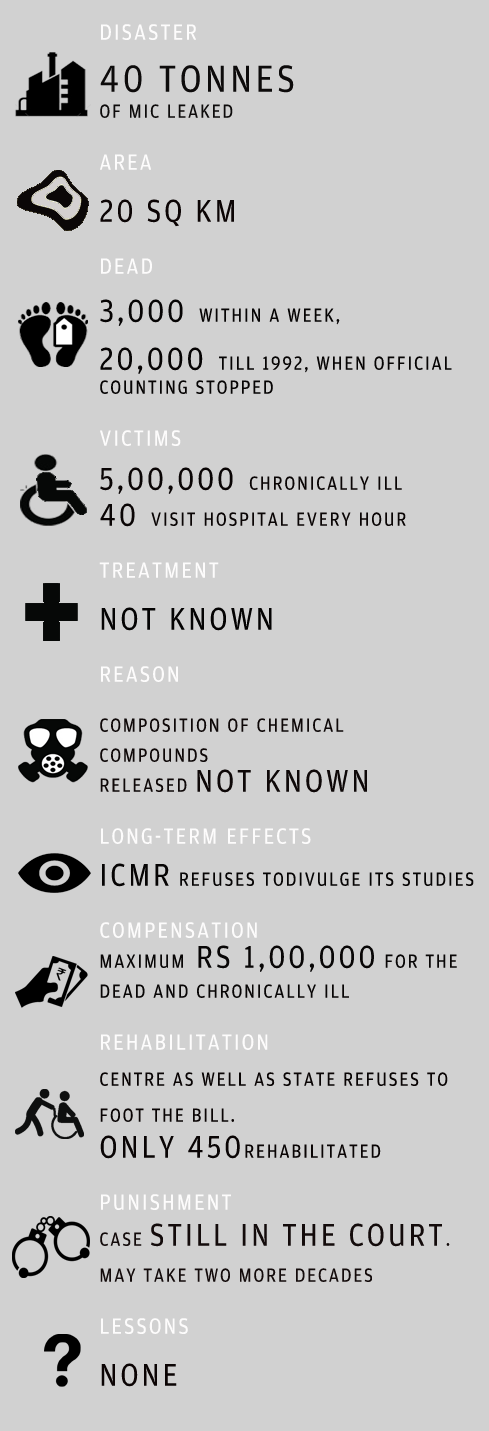 Newspapers also reported considerable resentment over the distribution of relief money. One gas-affected woman whose eyes had been badly affected wanted to return
the paltry relief money of Rs 200 that she had been given. Financial assistance was handed over in crossed cheques. To cash these cheques, the victims had to first get
them identified and open an account in the banks after depositing Rs 20. The banks had to seek special permission to open accounts for those poor families who did not even
have the initial deposit of Rs 20.
Newspapers also reported considerable resentment over the distribution of relief money. One gas-affected woman whose eyes had been badly affected wanted to return
the paltry relief money of Rs 200 that she had been given. Financial assistance was handed over in crossed cheques. To cash these cheques, the victims had to first get
them identified and open an account in the banks after depositing Rs 20. The banks had to seek special permission to open accounts for those poor families who did not even
have the initial deposit of Rs 20.Long Wait
In a desperate bid to get themselves cured, people sat in long queues before mobile clinics, dispensaries and polyclinics set up by the government, and a dozen other dispensaries set up by voluntary agencies. At these centres, they got the same treatment, antibiotics and a few other drugs, which after a while began to create more side-effects than benefits. Those unable to bear their health problems tried to seek the assistance of the big hospitals but from there they were invariably turned back. Others simply lay at home in bed. But with the government and the medical community in Bhopal arguing in less than a fortnight that the worst was over—that most of the problems people were now complaining about were mainly the result of common diseases like anaemia and TB rampant in these slums—the people found themselves caught between a callous multinational and a highly inefficient and equally callous government.
The government itself did not attempt any serious documentation of the extent of injury and new symptoms emerging. No effort was made to take X-ray, collect and analyse blood, sputum or urine samples and keep people under observation. Even worse, the entire affair was shrouded in total secrecy. Even as people complained of various ailments, the government tried to suppress all information. According to one report, the dean of the Gandhi Medical College in Bhopal even called a meeting of representatives of private medical practitioners in mid-January to demand that they disclose no facts pertaining to MIC poisoning to anyone but the state government.
Public protest
By early January, the mood turned angry and resentful. On January 1, Nagrik Rahat aur Punarwas Samiti organised a chakkajam (stop the wheels) programme by squatting on the main thoroughfare of the city. On January 3, the Zahareeli Gas Kand Sangharsh Morcha, a forum organised by scientists, social activists and trade union workers, observed a Dhikkar Diwas (day of condemnation) and a dharna (protest) in front of the chief minister’s house. The daylong dharna turned into a 10-day-long affair and finally got converted into a rail roko (stop the trains) programme.
The single biggest ground for resentment was the delayed distribution of ex gratia payments by the government, which had announced that Rs 10,000 would be given to the heir of every dead person, Rs 2,000 to those seriously affected and Rs 100 to Rs 1,000 to those slightly affected. In its initial panic, the government had rushed payments and Rs 36.67 lakh was paid in cash to 5,724 victims. But on December 7, the government suspended the disbursement and announced that it would be resumed later—and payment would be by cheque—only after a quick house-to-house survey of the affected localities.
The Bhopal tragedy has amply shown that it would be futile to expect the government to deal with such emergencies with any measure of efficiency. And yet high-risk industria lisation has made this an imperative.
Shama Bi
A lone survivor fighting after effects
Shama Bi is as old as the Bhopal gas tragedy. She was barely six months old in December 1984 and her
mother’s stories are her only link to what unfolded that night. The others in her family, brothers Shahnawaj (9) and Irfan (5) and father Inayat Mohammed, didn’t live to share their ordeal. While the leaking gas killed Shama’s parents and brothers, its after-effects have left her two sons suffering from mental illness.
After having three daughters, she and her husband had thought that the birth of sons would relieve them of their struggles in old age. But they soon noticed that the boys didn’t behave as other children. Their growth was also stunted. Five-year-old Mohammed Afsar and 14-month-old Mohammed Altmas have not reached the appropriate development milestones, making their condition a challenge for their parents.
Shama and her husband, both gas victims, have now started a grocery shop within their house. The prospect
of raising five children, two of them with disabilities, has left them mourning the coming days.
An activist
Balkrishna Namdeo was working on the issue of social security before the Bhopal gas tragedy.
After the gas leak, he brought the problems of gas victims under the banner of his
organisation and renamed it Gas Peedit Nirashrit Pension Bhogi Sangharsh Morcha. After
sustained campaigning by the morcha and other organisations, women who had been widowed by
the incident were rehabilitated in the Gas Widows Colony between 1989 and 1993.
Namdeo’s organisation is also fighting for compensation for the victims of the tragedy. There
is, however, a discrepancy in government figures. While giving compensation, the state
government had said that 5,295 people had been killed in the gas leak. But it contradicted itself
when, in the criminal petition filed in the Supreme Court, it stated that 15,342 people had been
killed.
A doctor who survived
Her family was one of the few fortunate ones that survived the gas leak. The moment she came to know about the leak, Bano, who was studying medicine at the time, made all her family members tie wet towels on their faces. The family immediately drove to her uncle’s house far from the factory. They returned a month later.
“The amount of gas-related cases that I see everyday makes me realise how fortunate I was to have managed to escape in time,” she says.
A mother from Arif Nagar
The night the gas leaked, Farzana, who was 15 then, was two months pregnant and mother to a one-year-old son. The family fled from Arif Nagar near the factory towards New Market and stayed in a camp there for three days. It was the only place which was providing food and milk free of cost. “When I have an attack, I feel like there is a steel plate vibrating inside my head. I get so mad that I can even kill a person. It becomes difficult for my husband to control me. My mother-in-law asked my husband to remarry because I could not have a healthy son. But he loved me too much to do so,” says Farzana.
Lali BaiA wedding party turns grim
On the night of the gas leak, a heavily-pregnant Lali was at Jahangirabad near the factory. She and her family were attending a relative’s wedding. Her daughter and step-daughter were sleeping on a chair nearby. She was waiting for her husband to take them home. All of a sudden, she started coughing violently. By the time she recovered, she realised everybody in the party was coughing and wheezing. The confusion continued for an hour until a few men came running to tell them that poisonous gas was leaking from a tank at the Union Carbide factory.
Lali and her husband picked up their daughters and walked towards the main road. Her eyes had started swelling from the smoke and soon she could not open them at all. Her husband requested a friend with a bicycle to carry Lali and their step-daughter to a safer place. He promised he would meet her with their daughter. After two days, a relative informed her that her husband and daughter had been found dead at Hamidia hospital.
A UCIL employee who never took compensation
On the night of December 2, Saeed heard sirens. He rushed out of his house and saw a white cloud rising
from the Union Carbide factory, where he worked as a production supervisor. He knew it was
poison and fled the area with his family. While most former employees kept away from the factory after the tragedy, Saeed was employed again by Union Carbide in 1993 to start decontamination of the site.
“We received a contract to dig out all the waste lying in the factory at the rate of Rs 1 per kg. We worked there till 1997,” says Saeed. Today, he runs a poultry farm.
“At times, I feel I got the tumour because of my exposure to chemicals during the decontamination work inside the factory. But what is the use of knowing what caused it? I have never taken compensation from the
government. I don’t want any compensation. If I have a disease, I will bear the burden with grace,” says Saeed. But one burden he finds difficult to bear is his daughter’s pain. Born in 1991, his daughter’s kidneys
failed when she was still young. Saeed’s wife gave one of her kidneys to their daughter.
The girl also has stunted body growth and suffers from depression and inferiority complex. She does not have friends. “My daughter is my princess. But no matter how much I tell her this, she remains upset with her looks. It kills me to see her this way,” he says.
A doctor who was on duty
He was pursuing a doctorate in medicine from Gandhi Medical College, Bhopal. It was a Sunday. The mess was closed during the night. He, along with others in the hostel, went and had dinner outside the campus. After having dinner, he went to his room. As it was winter, all the windows were closed. When he finally decided to sleep, he opened the window to get some fresh air.
As soon as he opened the window, his eyes started to burn. He received a call from the hospital and rushed to find that many others were
suffering from the same problem. There were many who were unable to even open their eyes. People were pouring in huge numbers. Some were vomiting, rubbing their eyes, crying. Many had lost consciousness.
An 18-year-old who lost her family
The horrors of the night refuse to leave her thoughts. Nushrat was only 18 when the poisonous gas swept through her locality, killing her parents and three younger sisters. It was around midnight when people started shouting in the street, asking everyone to escape. Inside, Nushrat’s family was already coughing and rubbing their eyes. Basheer, Nushrat’s father, stepped outside to find out what the noise was all about. He returned, picked up the youngest child—four-year-old Farat—and signalled to the others to follow him.
Shanawaz KhanThe first person to send a legal notice to UCIL
The Union Carbide India Ltd factory should have been red flagged much before the gas leak on December 2, 1984. A series of leaks on February 9 and October 2 that year had led to the death of many workers at the plant. But no precaution was taken. Shanawaz Khan, who is the first person to send a legal notice to Union Carbide, says a confidential report of the Union Carbide team in May 1982 had also warned of a leak due to “equipment failure, operation problems or maintenance problems”.
Photos: Living with the disaster
Khan was also a key witness in the CBI case. “The administration is favoring the Union Carbide management.
Union Carbide employed the sons and daughters of several ministers. The ministers’ family has been enjoying company-sponsored foreign trips. What can we expect of them?” asks Khan. On the night the gas leaked, Khan rushed to the Eastern Air Products plant and found all the workers in an unconscious state.
A victim of two gas leaks from the UCIL plant
Sajida Bano was only 17 when her husband, Ashraf Khan, factory fitter at Union Carbide, died of a phosgene leak at the plant. Ashraf had been asked to open a valve by his manager. This was in December 1981. She recalls how she felt her world collapse.
“Rs 50,000 was what the company fixed as the value of my husband’s life. I wanted to lodge a police complaint. But the company’s local lawyer, who later became a Congress leader, concealed the post-mortem report and bribed the police. I had to look after my sons. So I took the money,” she says.
It has been 30 years since her son died. Sajida still suffers from bouts of asthma. Even when she
is narrating her story, she feels dizzy and breathless. She expects nothing from the cases going on in court.
A former UCIL employee
Mohammad Rahman worked as a fitter at the Union Carbide Corporation (UCC) factory. On the night of the deadly gas leak, the factory alarm began to ring and workers were asked to stay out of the wind which was blowing through the cloud of smoke.
As Rahman waited with the rest of the workers, he had no idea that the gas leak was wreaking havoc in people’s lives in the city, including his own. The methyl isocyanate claimed the life of his unborn child. Rahman’s wife was six months pregnant. Around 3 am, Rahman and his colleagues were asked to assist the doctor at the factory clinic. Rahman recalls how patients were speaking to him one moment, and the next moment, they were dead. The scene left him in shock.
Resident of Sunder Nagar
Not a day passes when Abdul Qayyum Qureshi and his family don’t discuss the gas tragedy.
His son, Abdul Asif, was only a month old at the time. Qureshi looks after the 30-year-old man now. A child who could never sit up, Asif needs to be fed in his bed and carried to the bathroom. He is also intolerant of light and is kept in a room where the light is never switched on. Medical treatment has become a formality for the family. Doctors recognise Asif ’s family members and prescribe some medicines every time they visit. No one examines Asif anymore.
An ethnographer still making sense of the tragedy
After watching the Ramlila, Naval Shukla, a government ethnographer, was trying to sleep at his residence in Professor’s Colony when he heard a noise. Though he does not remember the time, he found his landlord had woken up too. When he came out, he saw thousands of people running on the road, many of them in their night dress. Some reports spoke of a bomb blast.
Zenab AnsariA mother of two near-blind children
Zenab laughs bitterly as she speaks of the night that changed her life. Had her grandparents been inside the house in Quazi Camp on December 2, she says, the family would have escaped the worst of the gas leak.
But they rushed outside on hearing Zenab’s grandparents cough in a strange fashion. The poisonous gas began to affect the rest of the family too.
Thirty years of unfulfilled promises by the government have destroyed Zenab’s faith in the system. Her husband Sayeed is a daily wage labourer who often spends his entire income on
the children’s treatment. Zenab doesn’t trust doctors anymore. At Hamidia Hospital in Bhopal, doctors asked to take a sample of Isha’s bone marrow, saying it would help them treat
the girl. Two years have passed but Zenab has not seen a single report on the sample. Her daughter’s condition has worsened and lodging a complaint, she thinks, would only be an exercise in futility.
A victim desperate to end his sufferings
Sanjay Yadav was 11 years old when the gas leak from the Union Carbide factory poisoned his life. He suffers from numerous health problems— poor eyesight, breathlessness and stomach ache. His wife, Sharda, was also a victim. The gas leak disaster took a toll on her eyes, and her nose bleeds every day. Their children—16-year-old Vikas, 14-year-old Aman and 12-year-old Vandana—are paying the price too. Vikas and Aman cannot walk. Nor do they understand anything.
He fears most for his children. “I am scared to even think of what will happen to them if we die. They are not entitled to any compensation. Every doctor says they were born this way because of the gas, but none one of them are ready to give it in writing,” he laments.
The doctor on emergency duty
It was around 11.30 pm on December 2 when H H Trivedi, professor of medicine (retired) at Gandhi Medical College, Bhopal, received an emergency call from the hospital. He had hardly reached the New Market area when he noticed huge crowds running towards him. He kept moving and opened the window of his car only to breathe a sharp smell. He reached the hospital coughing.
The situation in the hospital was worse. He recalls people vomiting, crying, frothing and dying. There were no beds, as more than 50,000 people were present on the campus. New patients were kept on the floor.
Students were informed and they rushed to hospital at around 3 am. They made stretchers out of their jackets to carry the patients as stretchers were not available. Many others institutions, such as the military, came forward for help.
A journalist
Around midnight on December 2, 1984, having finished a story for his newspaper, Raj Kumar Keswani went to bed in old Bhopal. When he was about to sleep, he felt a sharp pricking in his throat. He thought it was cold. Within few minutes, he was seized by a bout of coughing and breathlessness. Keswani also heard loud coughing sounds. When he looked from the window, he saw huge crowds coughing and scurrying for safety.
They had covered their mouths with whatever they could. A sense of fear prevailed that everybody was going to die. He called up a few friends. His wife reminded him about their parents and other family members.
A survivor with a cause
She was pregnant and the family had gone to sleep after watching a movie on Doordarshan. It was cold and the family had wrapped themselves in blankets. At around 12.30 am, her six-month-old son, Mohsin Ali, started coughing and crying. As she removed the blanket to see her son, she felt a pain.
On way to the hospital, she lost consciousness. When she opened her eyes 24 hours later, the doctor at Hamidia Hospital informed her about her miscarriage.
Sultan’s father and brother too died due to breathing problems, while her husband died fighting blood cancer in 2010. The gas also left her son Mohsin in a mentally and physically weak condition. Today, she assists a gynaecologist at the Sambhavna Clinic, which works for gas victims. “My whole life has gone in
meeting treatment costs,” she says. The government never plans with a holistic approach to rehabilitate gas victims, she adds.
A survivor who deals with the present
After death of her husband, she was awarded compensation of Rs 1 lakh. After four years, she was again awarded Rs 8 lakh. Later, she was also allotted a quarter in the Gas Pidit Colony. But there are no sewage or water facilities in the colony.
Though there is a water connection, they do not get water supply. Sewage lines are choked. Three years ago, Chief Minister Shivraj Singh Chouhan visited the place on Raksha Bandhan and named it Jivan Jyoti Colony. He promised to improve the condition of the colony, but nothing has happened so far. They continue to drink water knowing it is contaminated. She feels the government is not interested in improving the condition of the gas victims.
The gravekeeper
Mohammad Sayeed was alone in his house on the night of December 2. His wife and children had gone to their grandmother’s house on the outskirts of Bhopal. Sayeed, who worked at the Jahangirabad cemetery, was summoned after the first two bodies arrived at 1 am. It was here that he came to know about the poisonous gas leak that killed thousands. He first thought that the figures were exaggerated. “It was the year of riots, both Hindu-Sikh and Hindu-Muslim. Initially, I assumed it was a rumour. But when I had over 300 bodies to bury by 4 am, I realised it was the wrath of God,” he says.
The Bhopal tragedy made him realise the value of life. “People who lost their kin come here even after 30 years,” he narrates. One of them lost his eight sons, including a one-year-old. “He does not talk to anybody. He just sits near the graves. Sometimes, we see him sobbing and talking to the graves.” For many in Bhopal, time has stopped. “It seems people are still living in 1984. And the government has done little to heal their wounds,” Sayeed adds.
The policeman
On the night of December 2, 1984, head constable Ram Krishna Dwivedi was on duty at the Talaiya police station. At about 1 am, the air started getting heavier. Nobody knew what was going on. “By 2 am, it was confirmed that poisonous gas had leaked from the Union Carbide plant. We did not know what to do. Somebody asked us to wrap a wet towel around our face. That helped us a little,” Dwivedi says.
While others were trying to save their lives, Dwivedi went to rescue the family of his superior J P Pali, the station in-charge. “Pali saab was on his night rounds. I received a call from his wife. She was crying and pleading with me to save her and her daughter. I took the police jeep and brought them to my house which was under construction near Gupha mandir,” says Dwivedi.
The attendant at the cremation ground
He shudders every time he thinks of the night the toxic gas leaked. At the time, his wife was due to deliver and was admitted at the Sultania Hospital. As soon as Dholpuria heard of the gas leak, he took his children to the hospital and got his wife discharged. Together, they ran towards Kamala Park, the safer side of the city. On his way there, he saw more than 30 corpses lying on the road. Dholpuria used to assist in cremation at the Chola cremation ghat and realised he would soon be needed. He went to the crematorium and saw that there were 200 bodies waiting to be cremated. The vegetation around the pucca structure was cleared to make place for more pyres. Space was made behind the crematorium to bury children.
“The night was eerie. People were not crying. Even fathers of babies only a few months old were silent. It seemed the night had taken their voice away,” Dholpuria recounts. When there was no wood remaining, people started getting whatever they could lay their hands on. “We brought tyres and old broken furniture from peoples’ homes,” he adds. By 5 am, the number of bodies coming from the city was so high that a huge pyre was made to cremate 20 to 30 bodies at one go.
While Dholpuria says that the gas did not affect him, his family claims his lungs and kidneys are not functioning properly. When he fainted in his house some days ago, he was admitted to hospital. “The doctor had said I would not live longer. So I beat him up. But he asked the ward boys to tie me to my bed. He said I have lost my mental balance. Do I look like crazy to you?” Dholpuria asks.
A resident of the colony built on UCIL’s waste dump
Naseeruddin forces every social activist or journalist visiting his colony to drink the water at his home. “If they don’t drink this water, how will they know the real condition
that we live in?” he asks. Now a father of two, Naseeruddin was a child when the gas leaked and claimed the lives of his parents, brothers and sisters. He was with his grandmother in Sivni, a few kilometres from Bhopal, when the tragedy happened.
“Some researchers from the city collected water from our colony. We learnt that the water contained several harmful elements, which are present even after boiling. The government that allotted us flats here must have known and yet, they built a colony here,” he says with anger. Sustained campaigning with the help of non-profit organisations forced the administration to provide a drinking water pipeline to New Moon Colony. But life is not easy. “Piped water comes for half an hour, and there is no fixed time. If you miss
it, you have to drink water from the tube wells,” he complains.
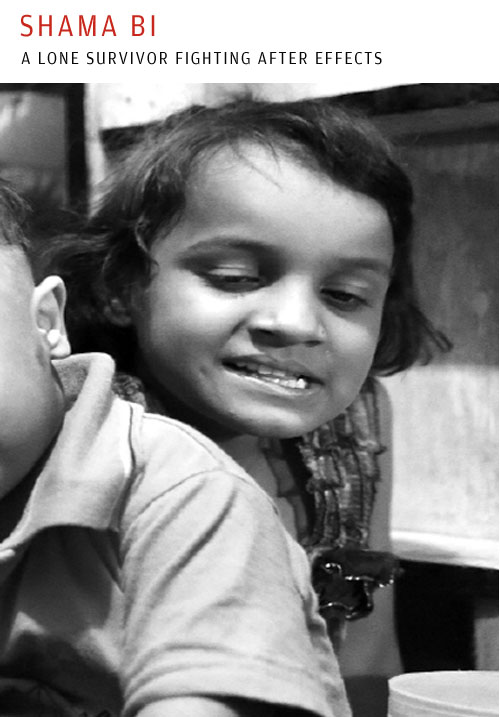

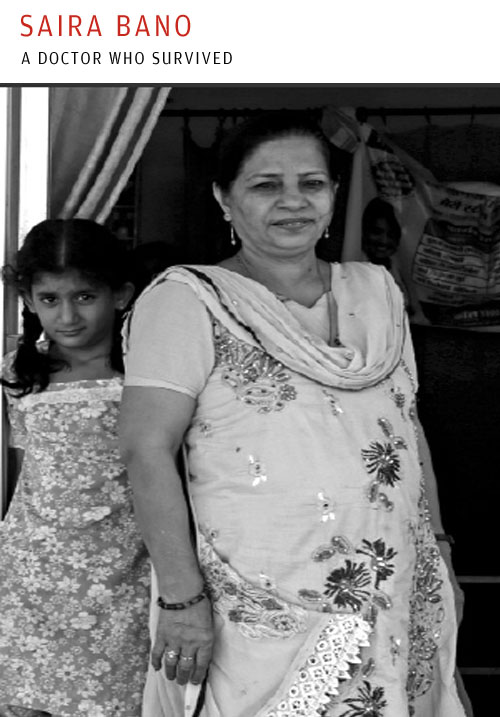
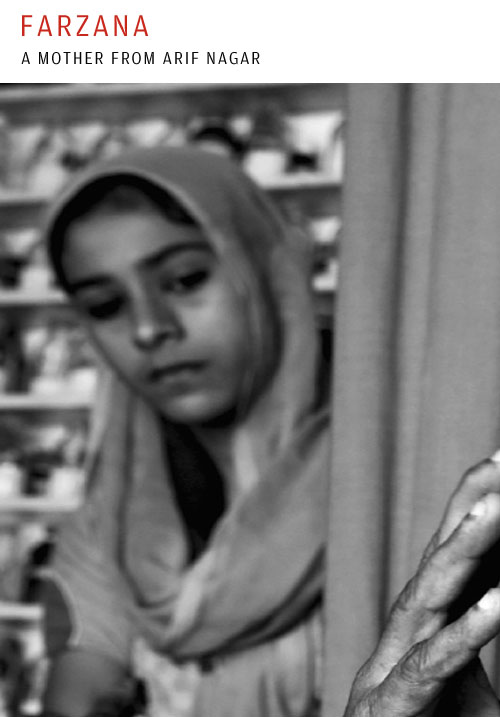

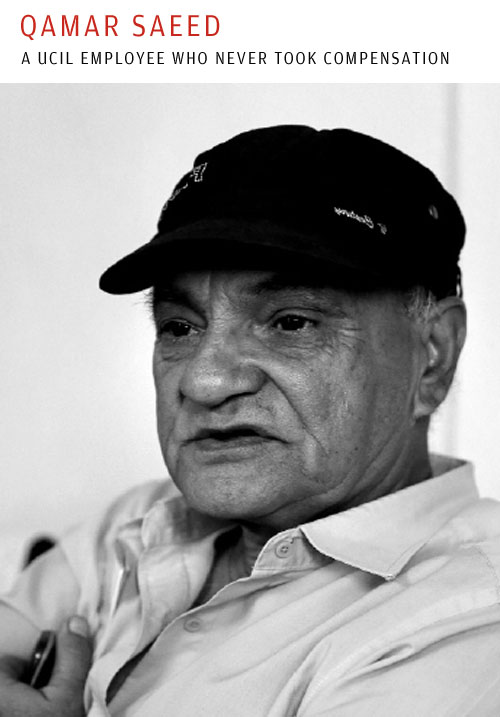

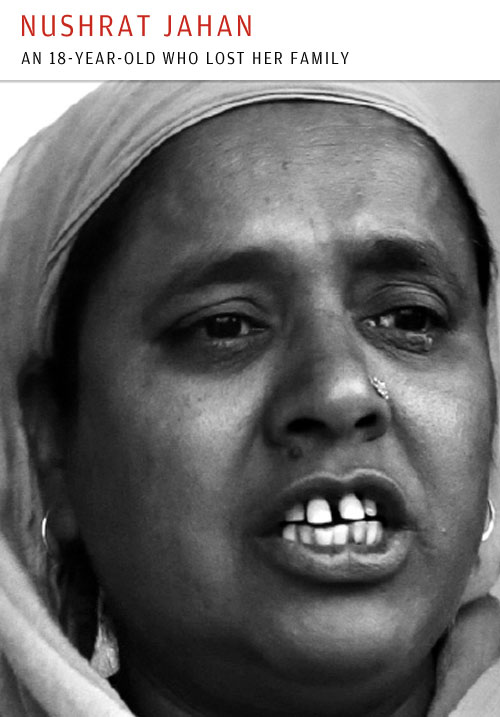
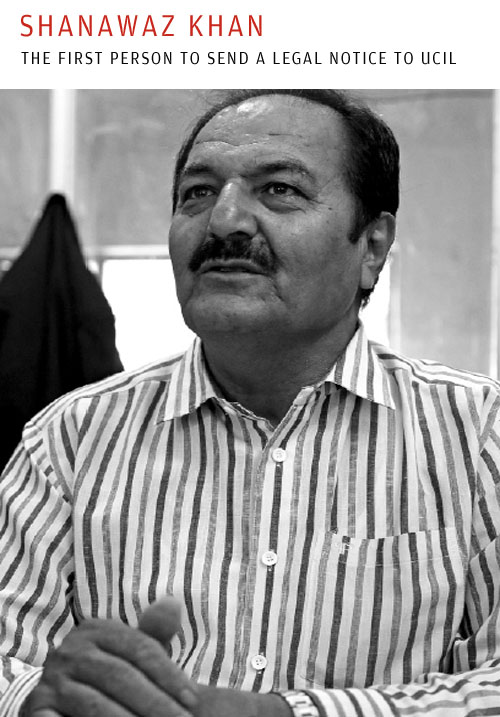
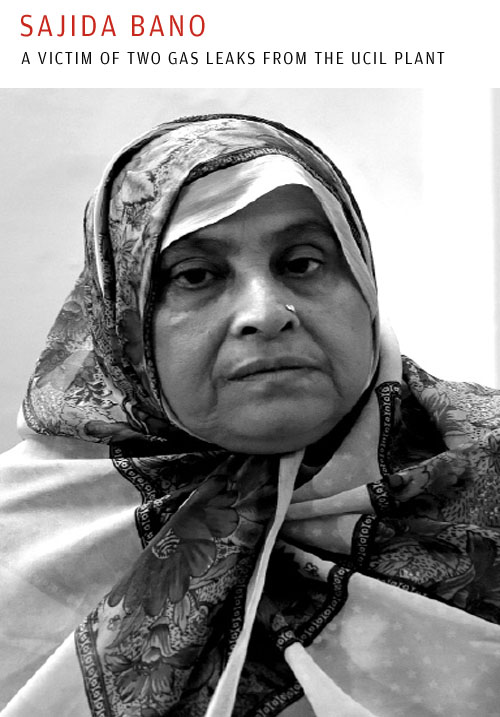
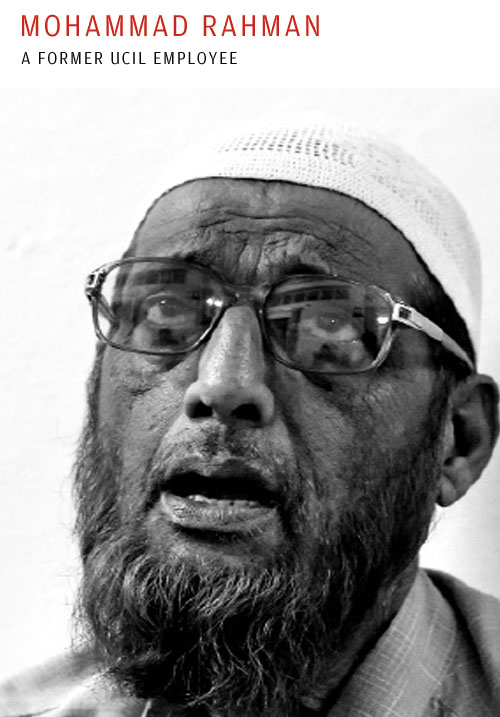

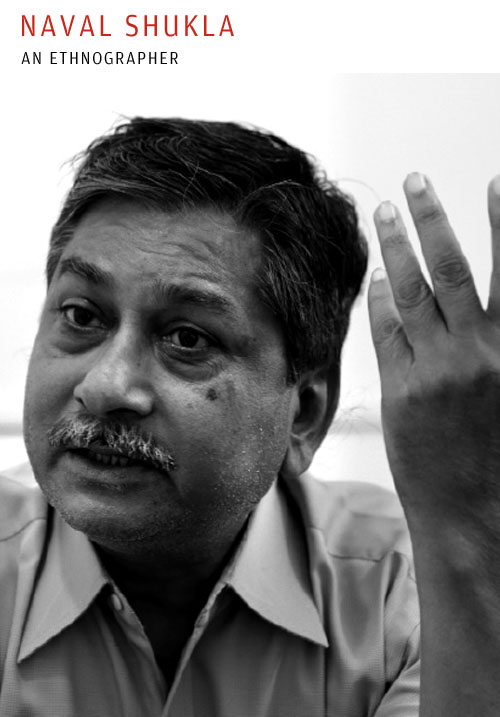
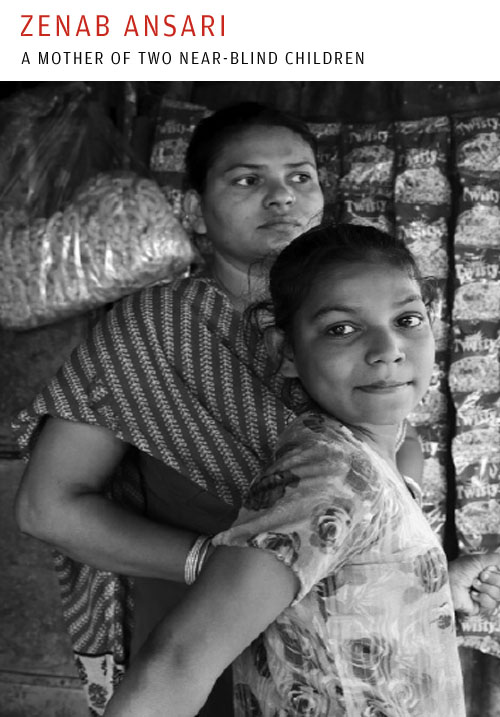

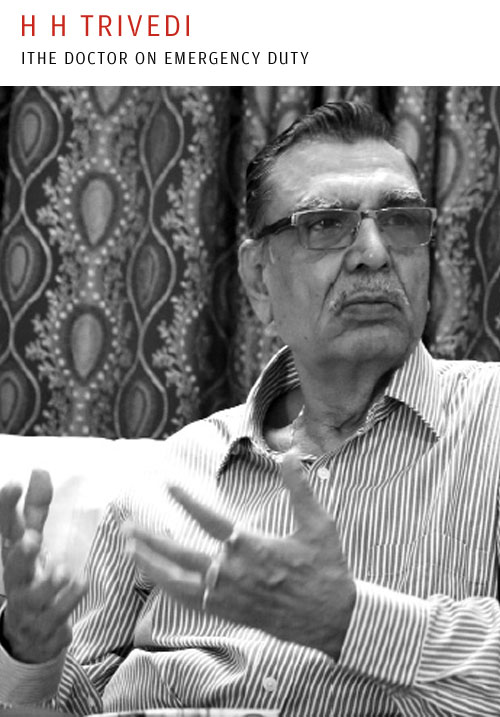

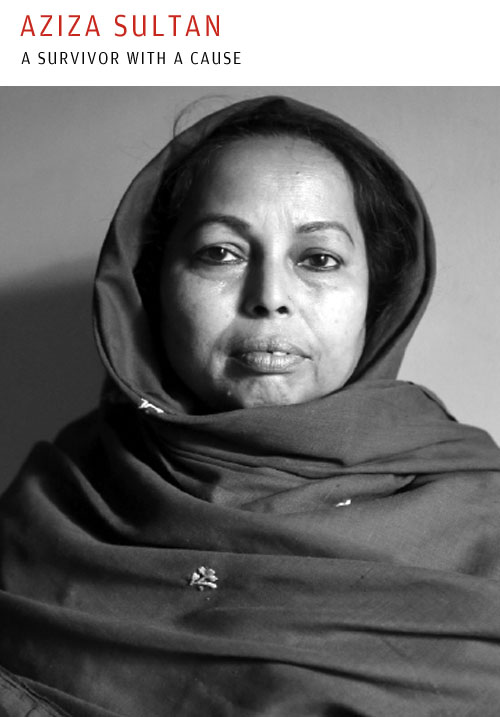



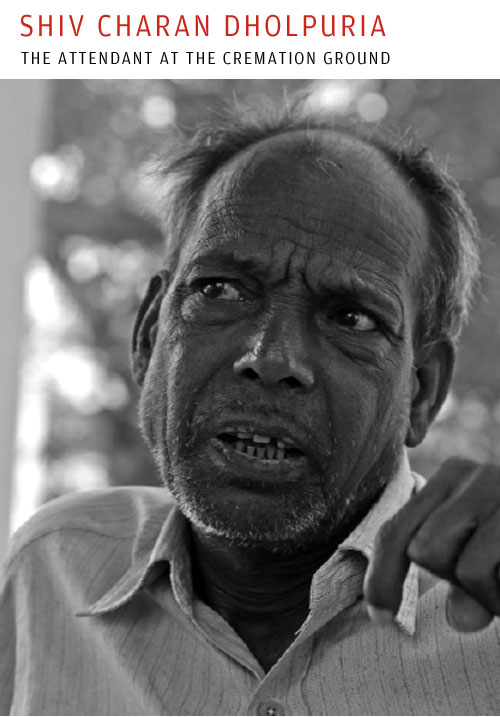
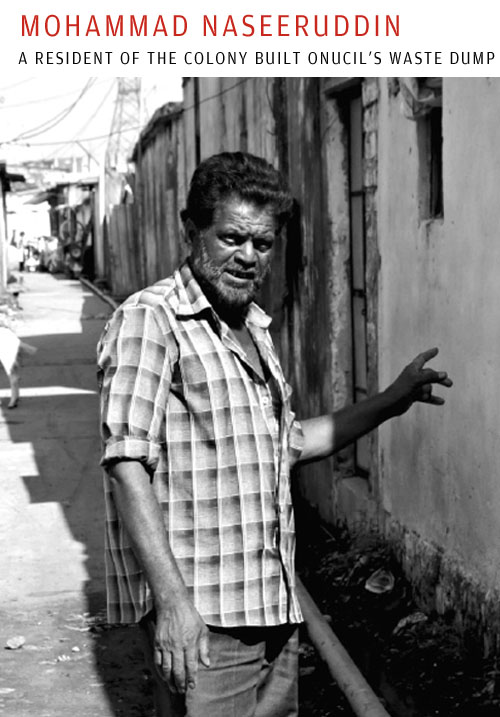
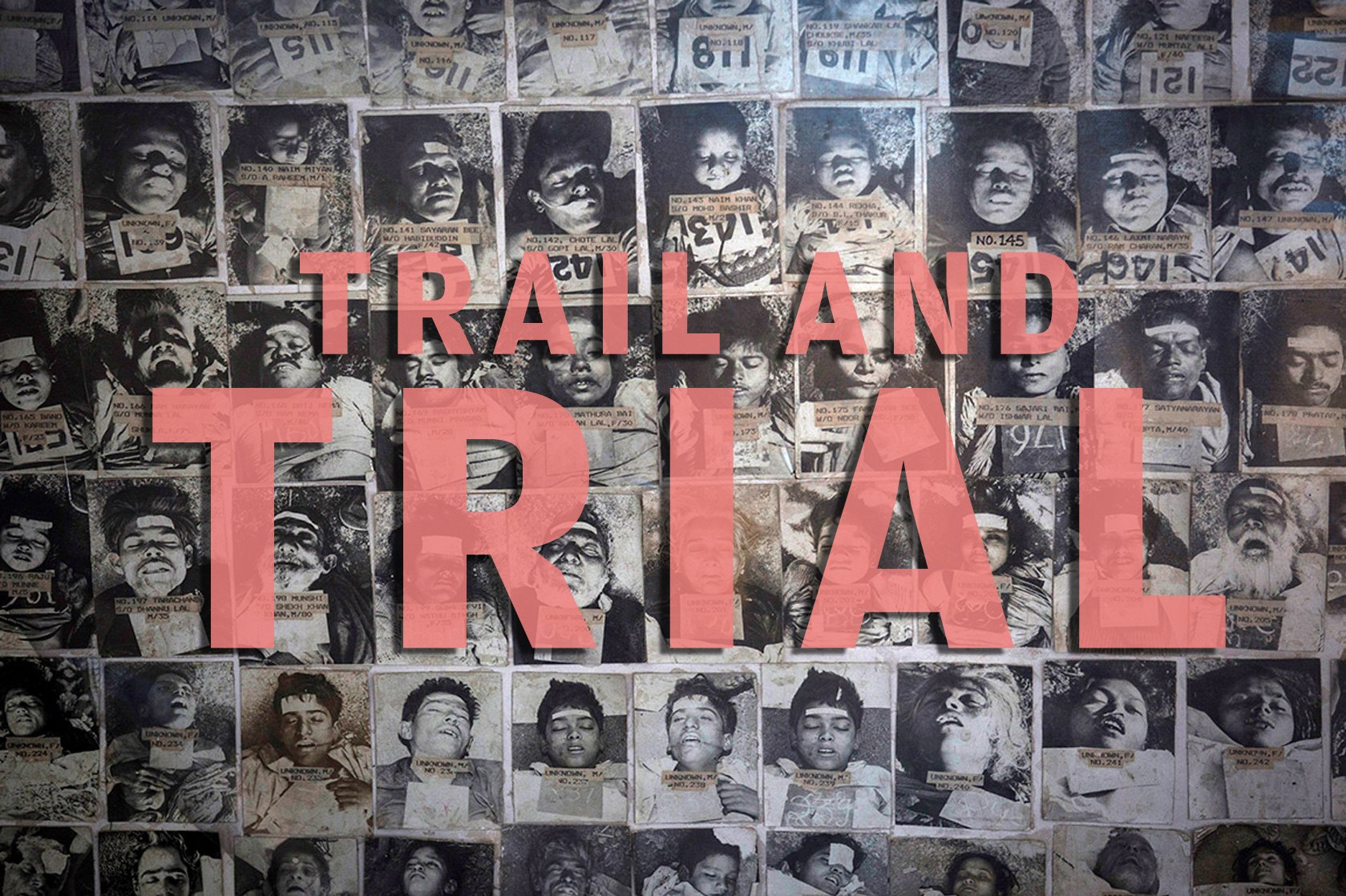
Thirty winters since the Union Carbide factory in Bhopal caused India’s biggest industrial disaster, water and soil around the factory are still loaded with hazardous chemicals
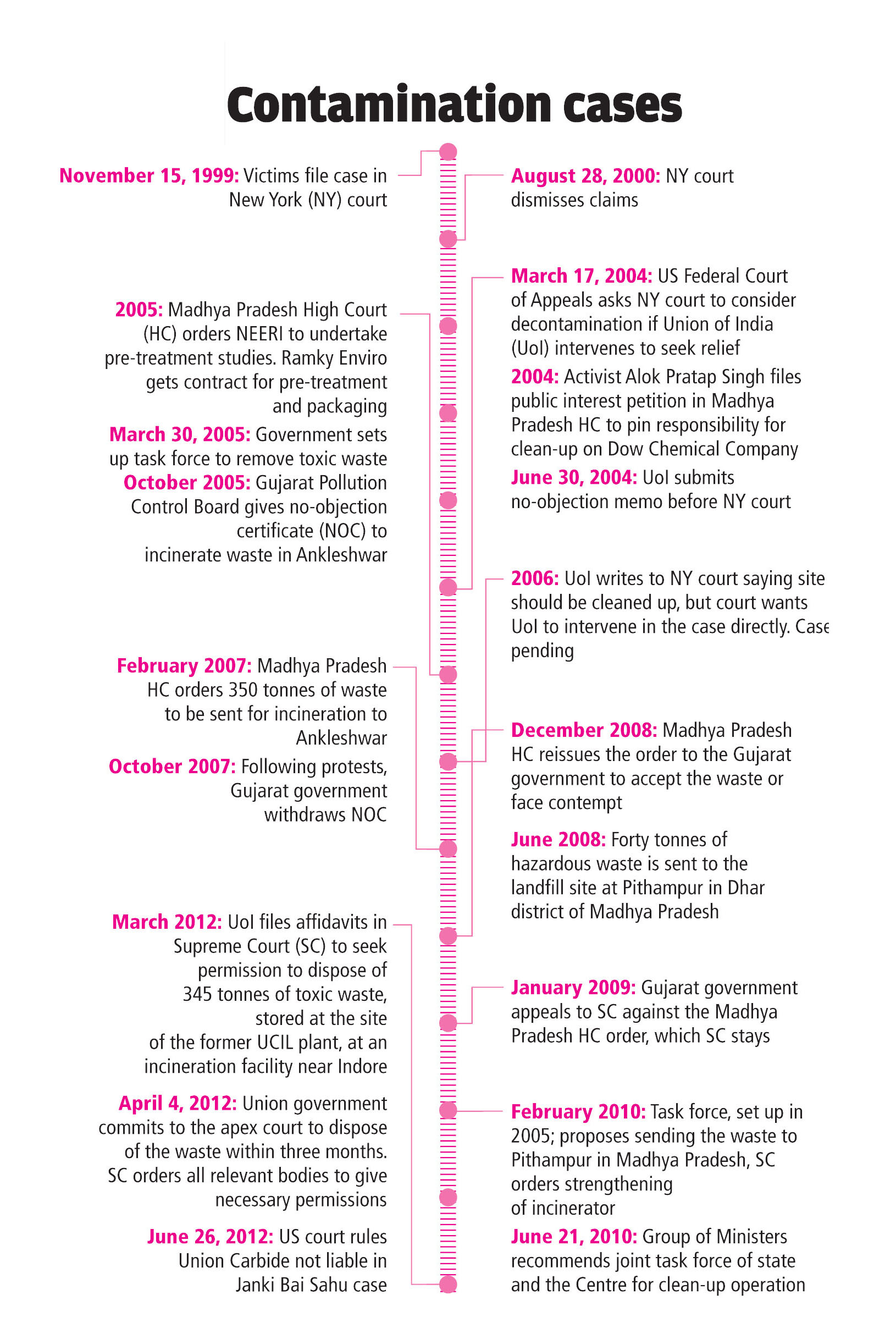
In the past 10 years, toxic waste in and around the factory has come under public scrutiny. But decontamination is not high on official agenda
Like the eye of the storm, ground zero of the Bhopal gas disaster, the defunct pesticide factory, remained out of public discourse as each and every one related to the disaster focused on the pressing health and relief issues. For over 31 years after the disaster, nobody paid attention to the hazardous waste at the abandoned factory.
During 1969-84, Union Carbide India Limited (UCIL) produced mainly three pesticides, Sevin (carbaryl), Temik (aldicarb) and Sevidol, which is a formulation of carbaryl and gamma-hexachlorocyclohexane (y-HCH). All these years, the toxic waste and products were being dumped at certain areas inside the plant and outside in the solar evaporation pond (SEP). After the gas leak, it was shut down but the highly toxic waste dumped has been languishing on the plant premises and in the pond ever since. According to T R Chouhan, a former plant operator with UCIL, during 1969-1984 about 500 tonnes of toxic waste was dumped at the UCIL site. In the narrow lanes of Old Bhopal, if a person has a piece of paper stuck in heror his pocket, you know it is a doctor’s prescription. This city is a living memorial to the world’s largest industrial accident. The people here clutch atthe prescriptions like they hold on to the memories of that night when they became “gas victims”. With the impacts of the gas leak manifesting across generations, the need for medical care has increased. Even though the cityhas better healthcare facilities than most parts of Madhya Pradesh, it still falls short of providing the kind of care victims need.
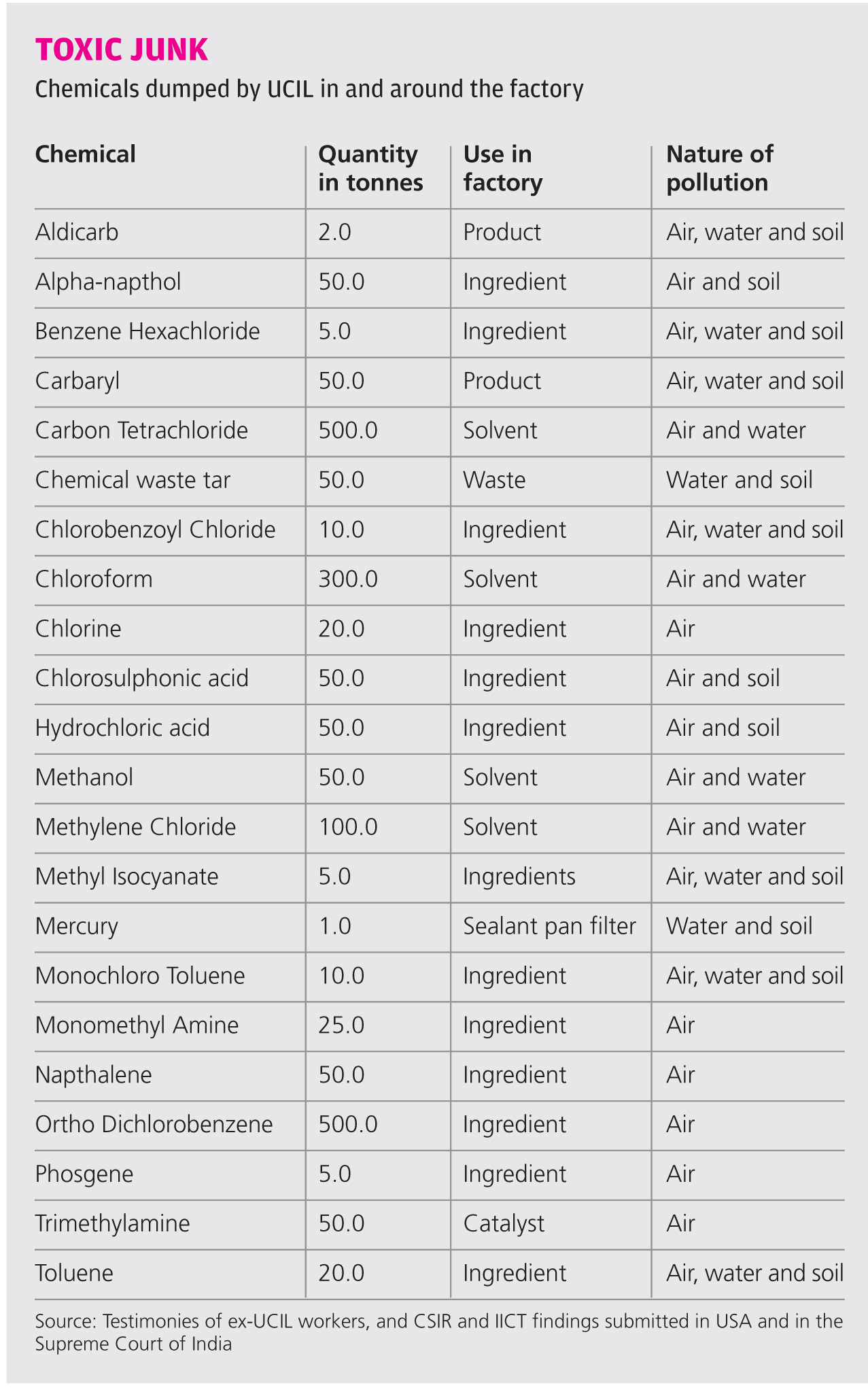 Qamar Saeed, who was production supervisor of the methyl isocyanate (MIC) unit atthe factory, and was later engaged by the company in 1993 to decontaminate the site, says by 1997 there was still 10,000 tonnes of toxic waste lying in the plant unprotected. His team worked till 1997 to put all the waste into gunny bags. “The toxic waste kept in the factory godown that the world talks about was actually packed by ourteam,” says Saeed
Qamar Saeed, who was production supervisor of the methyl isocyanate (MIC) unit atthe factory, and was later engaged by the company in 1993 to decontaminate the site, says by 1997 there was still 10,000 tonnes of toxic waste lying in the plant unprotected. His team worked till 1997 to put all the waste into gunny bags. “The toxic waste kept in the factory godown that the world talks about was actually packed by ourteam,” says Saeed
After 30 monsoons, the waste has spread to areas much beyond the site and leached into groundwater. It has been a continuous source of soil and groundwater contamination. As the residents in the area use groundwater the most even today, it has become a subject of intense public agitation and scientific study to examine the impacts on human health. One way, this is another Bhopal tragedy that brewed for decades without being noticed.
See also: Bhopal gas disaster: the tragedy continues
The NEERI report available with activists in Bhopal shows it did find pesticides, from Sevin (carbaryl) to Lindane and alpha naphthol. NEERI officials confirmed to Down To Earth that they had indeed found high levels of toxins and had identified the contamination hot spots in the factory. Arguably, this was the first time the toxic waste inside the plant came into public focus. In the past, residents of the area and former employees of UCIL had raised fear on this aspect, and not without reasons. Internal documents of UCIL show that its parent company UCC was aware of numerous events at the Bhopal plant which had serious consequences for the environment. Back in 1973, UCC’s engineering department warned that the design of the Bhopal plant, which used solar evaporation pond for waste effluent, posed a threat of polluting sub-surface water supplies in the Bhopal area. An internal memo the same year notes, “Similar waste streams have been handled else where, this particular combination of materials to be disposed of is new and, accordingly, affords further chances for difficulty.” In 1999, the international non-profit, Greenpeace, conducted a study similar to that of NEERI in and around the factory. This report also confirmed contamination ona massive scale. This was also the time when the big sale was taking place: Union Carbide was sold to The Dow Chemical Company, another US chemical giant. Citing the findings of this report, Bhopal activists took the matter to the New York district court. They demanded relief for personal injury and property damaged because of the continuing release of pollutants from the factory. The battle in US courts continues till date.
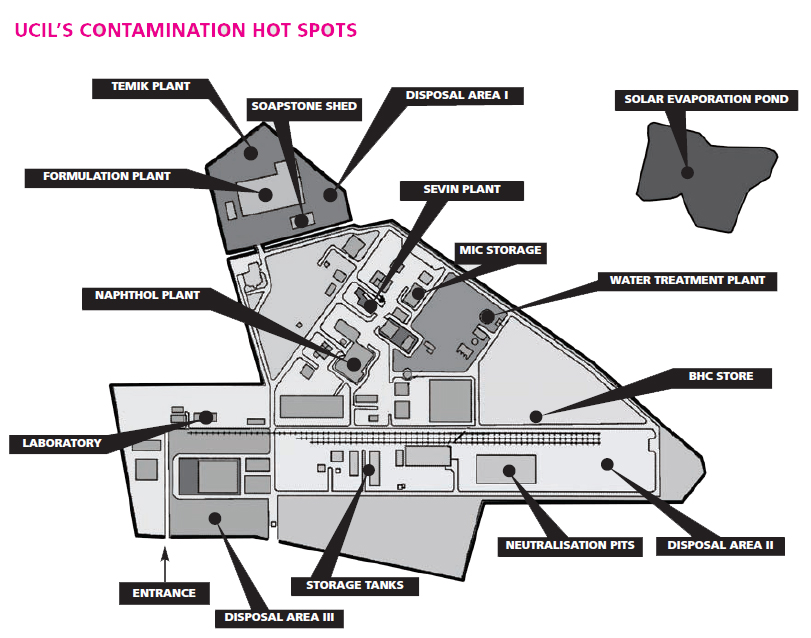 In May, June and July 1989, UCC conducted “preliminary” tests on solid and liquid samples drawn from “land-fill areas and effluent treatment pits inside the plant”. Both liquid and solid samples were toxic to fish. The solid samples contained naphthol or naphthalene insubstantial quantities, the liquid samples contained “naphthol and/or Sevin inquantities far more than permitted by the Indian Standards Institution (ISI) standards for on land disposal”. Some water samples produced a 100 per cent death rate among fish placed in them.
In May, June and July 1989, UCC conducted “preliminary” tests on solid and liquid samples drawn from “land-fill areas and effluent treatment pits inside the plant”. Both liquid and solid samples were toxic to fish. The solid samples contained naphthol or naphthalene insubstantial quantities, the liquid samples contained “naphthol and/or Sevin inquantities far more than permitted by the Indian Standards Institution (ISI) standards for on land disposal”. Some water samples produced a 100 per cent death rate among fish placed in them.
See also: BHOPAL - the bad dream continue
This set of documents prompted people to approach courts and the issue of waste and its health impacts came under formal judicial scrutiny. In 2004, Alok Pratap Singh, an activist in Bhopal, filed a public interest petition in the Madhya Pradesh High Court. He petitioned that Dow be held responsible for the pollution at the site and sought directions from the court establishing the liability of the company for continuing and long-term impacts. His petition also asked for a quick clean-up of the site.
In 2007, information sought under the Right To Information Actmade another exposure: the state government was also holding back information on the contamination of the plant site. Quarterly monitoring reports on groundwater quality between October 1996 and July 2007 indicated the presence of toxins and chemicals such as trichlorobenzene, lindane, benzene hexachloride, heptachlor, mercury, nickel and cadmium. At that time, more than 25,000 people had been using this water.
These are known to damage the liver, kidneys, brain and the reproductive and immune systems, as well as cause cancers and birth defects. According to the Bhopal Group for Information and Action that got the information through the RTI Act, the pollution board had not only suppressed this vital information for five years, it had also deliberately stopped testing samples for certain chemicals once the problem had been identified. In November 2005, for instance, after finding trichlorobenzene to be eight times higher in concentration than the limits prescribed by the World Health Organization, none of the samples collected in the eight quarters in 2006 and 2007 was tested for this chemical.
Nature of contamination
Over the years several studies have been conducted to assess the level of contaminationin and around the Carbide site and to outline the fate of the factory. Delhi-based non-profit Centre for Science and Environment (CSE) has analysed 15 studies done over the past 20 years. These studies were conducted by non-government organisations; Central and state agencies, such as the pollution control boards; and the institutes ofthe Council of Scientific and Industrial Research, such as NEERI, National Geophysical
Research Institute (NGRI), Indian Institute of Chemical Technology (IICT) and the Indian Institute of Toxicology Research (IITR). The focus of the studies has been soil and groundwater contamination.
Waste at the factory
In limited studies, the waste with in the UCIL site was found to contain a wide range of chemicals in high concentrations. Carbaryl, aldicarb, HCH
somers and alpha naphthol were most common organic contaminants found. Among heavy metals, manganese, zinc, copper, nickel, lead and chromium were found. Waste dumped in the SEP area, particularly the landfill, needs to be assessed further.
Soil contamination
Organic contaminants such as carbaryl, aldicarb, HCH isomers, chlorinated benzenes and alpha naphthol were found in soil samples in most of the studies. Similarly, heavy metals such as mercury, lead and chromium were also commonly found.
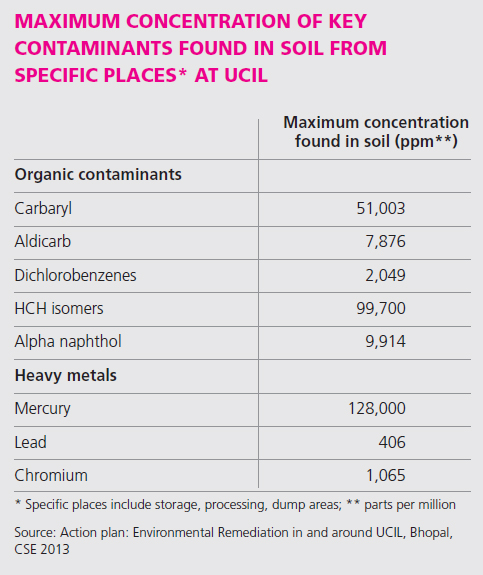 Several places inside the factory, such as the neutralisation pits and the Sevin plant, were found heavily contaminated with multi pleorganic chemicals and heavy metals.
Most of the contaminants found in soil could be linked with the production process in the UCIL plant. Organics like carbaryl, aldicarb, HCH isomers, chlorinatedbenzenes and alpha naphthol and heavy metals like mercury and chromium were either the final products or were being used in production process. The maximum concentration of key contaminants found is very high.
Several places inside the factory, such as the neutralisation pits and the Sevin plant, were found heavily contaminated with multi pleorganic chemicals and heavy metals.
Most of the contaminants found in soil could be linked with the production process in the UCIL plant. Organics like carbaryl, aldicarb, HCH isomers, chlorinatedbenzenes and alpha naphthol and heavy metals like mercury and chromium were either the final products or were being used in production process. The maximum concentration of key contaminants found is very high.
Groundwater contamination
Most of the studies found groundwater from the areas surrounding the Carbide site to be contaminated with organic contaminants. Common organic contaminants were chlorinated benzenes and HCH isomers. Carbaryl, aldicarb, carbon tetrachl-oride and chloroform were also detected insome studies. Heavy metals such as mercury, lead, chromium, manganese, zinc, nickel and copper were found in studies conducted by non-profits and government institutions such as IITR and the Central Pollution Control Board.
A joint study to NEERI-NGRI to assess contamination in and around the Carbide site and delineate suitable strategies. It involved a survey ofthe site, geophysical and hydrological investigation, sampling and analysis of soil and groundwater. According to this study, at most places the soil was contaminated up to a depth of two metres. Key contaminants found in the soil include cabaryl, aldicarb, HCH isomers and alpha naphthol and heavy metals such as mercury, lead and chromium. They only found isolated contamination, which was attributed to the annual surface run off during monsoon. NEERI explained that the main reason for the limited movement of contaminants towards the groundwater is extremely low permeability (of the order of10-9 cm/sec) of the black and yellow silty clay in and around the plant site.
CSE study
In 2009, to mark the 25th anniversary of the tragedy and to bring out independent assessment of the contamination due to the toxic waste, the pollution monitoring laboratory of the CSE carried out tests that showed the water and soil in and around the Union Carbide factory were loaded with pesticides. CSE first studied the chemistry of the processes used for producing various pesticides in UCIL and based on it, selected four groups of chemicals for testing soil and water samples. In chlorinated benzene compounds it tested 1,2 dichlorobenzene, 1,3 dichlorobenzene, 1,4 dichlorobenzene and 1,2,3 trichlorobenzene. In organochlorine pesticides it tested alpha, beta, gamma and delta-hexachlorocyclohexane (HCH). The two main products of UCIL, namely carbaryl and aldicarb, were also tested. Five heavy metals—lead, cadmium, chromium, mercury and arsenic—were also tested.
UCIL used to buy technical grade HCH, which is a mix of several chemical forms(isomers) of HCH (mainly alpha, beta, delta and gamma HCH,or g-HCH). It would extract g-HCH from the technical grade HCH for making pesticide Sevidol and throw the remaining isomers as waste within the factory and outside in SEP. The other two pesticides, carbaryl and aldicarb, fall under the carbamate group ofinsecticides. Both are moderately persistent, highly toxic and highly water soluble andmobile in soil. It is, there fore, not surprising that CSE found both these pesticides in the soil and water in and around the factory.
HCH and its isomers found in samples are highly persistent and toxic organochlorine pesticides. Hexachlorobenzene (HCB) is an impurity in the technical grade HCH and was also produced as a by product of various chemical processes in the factory.
Chlorinated benzene compounds are highly persistent and were either used by UCIL as solvents or were degradation products of HCH or HCB. For instance, 1,2 dichlorobenzene was used as solvent for producing alpha-naphthol, a chemical used in the production of Sevin, the main product of UCIL. Chlorinated benzene compounds are also used as insecticides and fungicides. Heavy metal like mercury was used as a sealant in the Sevin plant and chromium was used as a coolant in the cooling plant of the factory. Scientists from the CSE lab visited Bhopal on October 28-29, 2009, to collect soil and water samples. They collected eight samples.
One sample was taken from the waste storage shed in UCIL that has the waste the government is trying to send to a hazardous waste disposal site. Six soil samples were collected from various places inside the factory. The last soil sample was collected from the solar evaporation pond. Similarly, the scientists collected 12 water samples. One water sample was taken from inside the factory, which is rain water collected in a ditch on the plant premises,and rest 11 samples were from hand pumps, bore wells and dug wells from areas around the factory.
The samples were collected from colonies next to the plant’s boundary wall to as far as 3.5 km away from the factory. One stored waste sample, six soil samples and one surface water sample in the factory and one soil sample from the waste disposal site (SEP) clearly show that the land within the factory and the waste disposal site are highly contaminated with pesticides, organic compounds and heavy metals.
Waste sample
The waste stored within the UCIL premises had all four chlorinated benzene compounds and six of the seven pesticides. Carbaryl content in this sample was as high as 9,856 parts per million (ppm).
The sample also had four of the five heavy metals. Mercury content was 1,065 ppm.
Soil samples
HC Hand its isomers, HCB, 1,3 dichlorobenzene and 1,4 dichlorobenzene were detected in all soil samples. In five soil samples 1,2 dichlorobenzene and 1,2,3 trichlorobenzene were found. Aldicarb was found in three samples and carbaryl in one. The total pesticide and chlorinated benzene compounds content in the samples ranged from 185 ppm (in a pond near the boundary wallat the Atal Ayub Nagar side) to 5,874 ppm (from the Sevidol formulationplant). The gamma-HCH(lindane) content in the soil sample from the Sevidol formulation plant was 2,782 ppm. Arsenic and chromium were found in all soil samples. Mercury was found in two samples and lead in five of the six samples. Chromiumwas found in the range of 18 ppm to 298 ppm, the highest concentration being near the Temik plant.
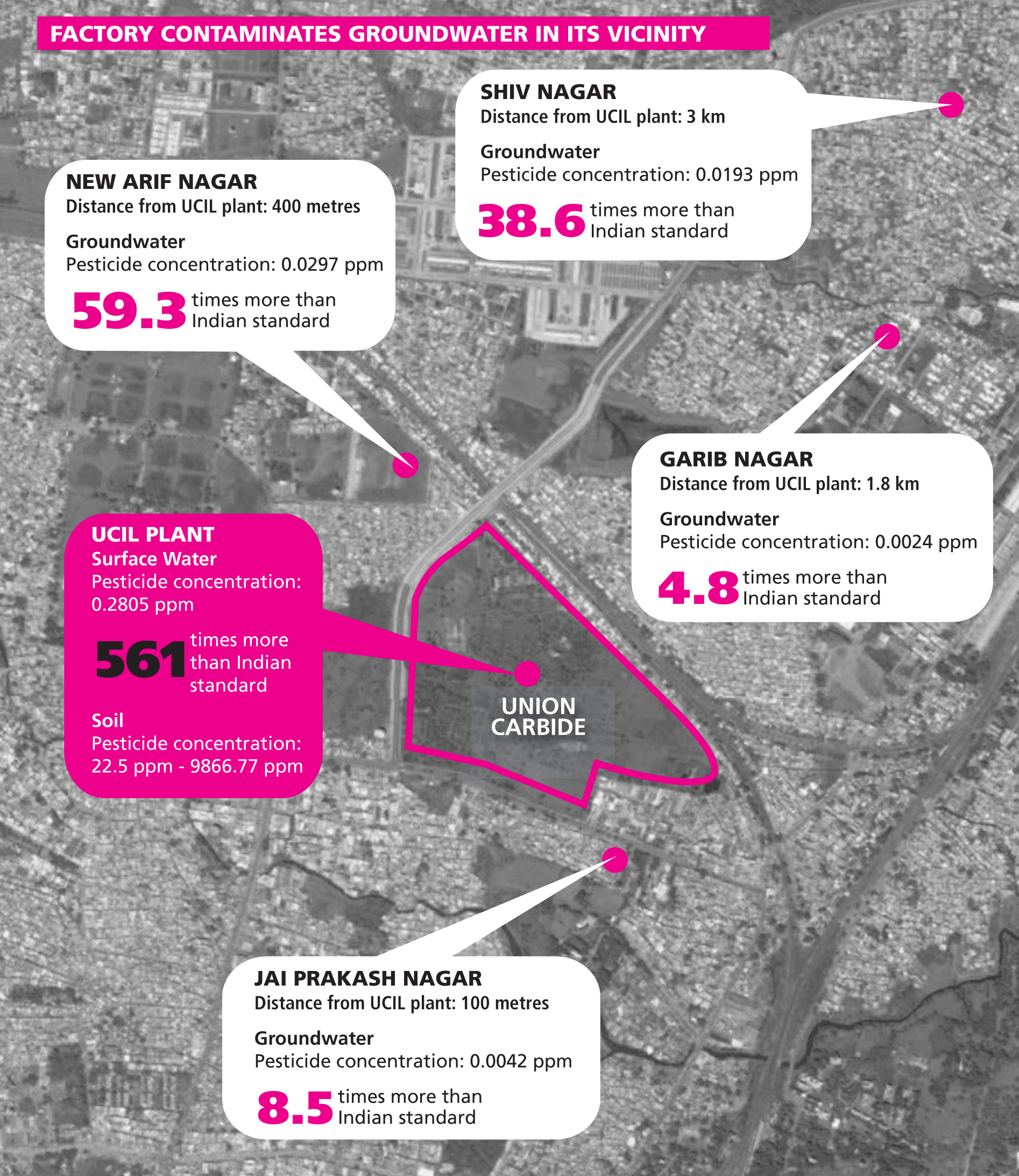 Mercury concentrations were found to be very high. In the soil sample collected from the floor of the Sevin plant, the concentration was 8,188 ppm. Even now elemental mercury can be seen inside the Sevin plant. Water sample: The surface water sample collected within the factory premises had the highest level of contamination and all compounds tested for were found.
Mercury concentrations were found to be very high. In the soil sample collected from the floor of the Sevin plant, the concentration was 8,188 ppm. Even now elemental mercury can be seen inside the Sevin plant. Water sample: The surface water sample collected within the factory premises had the highest level of contamination and all compounds tested for were found.
Waste dump site
The soil sample contained all chlorinated benzene compoundsand organochlorine pesticides. It also had four out of five heavy metals. Chromiumcontent in this sample was 1,065 ppm. UCIL was using chromium as coolant and wasthrowing cooling water in the solar evaporation pond. Contamination outside: All 11 groundwater samples collected from colonies around the factory were contaminated with chlori-nated benzene compounds and organochlorine pesticides. Carbamates were found in four groundwater samples. Concentration of pesticides found in all water sample swas 1.1 to 38.6 times higher than the only mandatory Indian water standard, fixed by the Bureau of Indian Standards (IS:14543).
The average concentration in all groundwater samples was 0.006 ppm, which is 12 times the standard. The water sample from a hand pump near Chaurasia Samaj Mandir in Shiv Nagar was the most contaminated. It has the highest concentration of carbaryl (0.011 ppm or 110times the standard), lindane (0.004 ppm; 40 times the standard) and mercury(0.024 ppm; 24 times the standard). This place is over3 km from the UCIL factory.
The CSE test further confirmed the linkages between the toxic dumps and the contamination of soil and water in and around the plant site. The profile of chemicals found within the factory and in its waste disposal site matches the chemicals found in the groundwater sample in the colonies outside the factory premises.
There is no other source of these chlorinated benzene compounds and pesticides. The topography of the area also points towards contamination of the groundwater by UCIL. The plant is located at a slightly higher altitude than the residential colonies with a gently sloping terrain.
State in denial
Gaur cited as evidence a letter from the Defence Research and Development Establishment (DRDE), Gwalior, which says it found nothing alarming in samples it tested for toxicity in its laboratory. On the contrary,all samples excavated from waste, lime sludge, naphthol tar, reactor residue, semi-processed pesticide and Sevin tar have low mammalian toxicity, according to experiments done on animals. DRDE director R Vijayaraghavan explained to Down To Earth: A 70 kg man will not dieif he takes 200 gm of the waste orally or eats 100 gm of sevin tar. In fact, the toxicity is less than that of table salt. So the director concluded thatthe site could be opened to the public.
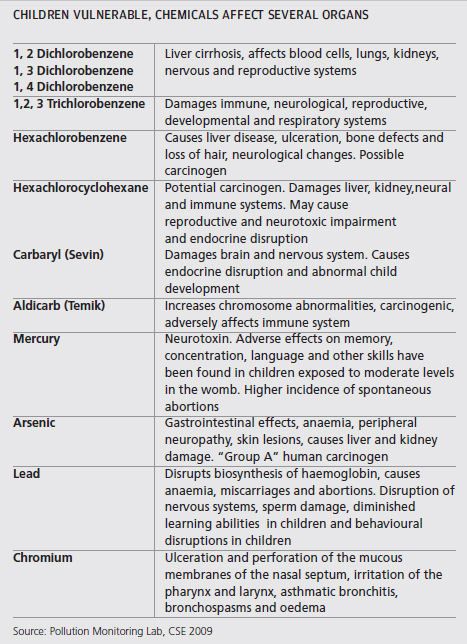
While the government preferred denial, in 2013, yet another study confirmed that the groundwater around the Union Carbide factory is contaminated. In its report submitted to the Supreme Court on September 25, IITR stated that the levels of heavy metals like lead, nitrate and nickel are much more than the permissible limits set by BIS. The report found that nitrate levels exceeded in nine of the 30 samples, while leadwas high in almost 24 samples. It also stated that the contamination is spread over to 18 colonies in the area. The Supreme Court asked IITR to carry out another survey because the “samples taken for the present survey were done during the monsoon season, thus diluting the chemicals in the water”.
The report is yet to be released. The IIT Rreport had also stated that the contamination is not a health concern because the drinking water supply in the area comes from the municipality and not the groundwater. This, however, is not true. Several residential colonies around the factory are forced to drink the contaminated groundwater either because they do notget the municipal water supply or the supplied water is worse.
In several areas people complain that the water pipelines have been laid so close to the sewer lines that the sewage of ten mixes with the water. “The water from these pipelines stinks of sewage,” says Mohammad Naseeruddin, a resident of Blue Moon Colony, situated on the land which was once the solar evaporation pond of the factory. When Justice Ajit Singh, who heads the Supreme Court-appointed monitoring committee for gas victims, came to inspect the availability of drinking water in gas-affected colonies in June 2014, Naseeruddin offered him a glass of water from the tap.“It was important to show him what we drink,” he says. Other people in the 22 colonies where groundwater is found to be contaminated have also complained about the poor supply of drinking water. In 2012, the Supreme Court had directed the Madhya Pradesh government to resolve the water supply and contamination issues within three months. Many areas still do not have water pipelines.
More waste
While the court cases and the slow government reactions on waste disposal continue, there is another challenge that may complicate the issue. Many experts, including those representing government scientific institutions like the NEERI, think the site has much more waste than estimated. During CSE’s interactions with various government and non-government institutions and experts for putting together a roadmap to clean the site, it emerged that more dumps are likely to be “discovered” at the plant site. This means any plan to search for remediation has to start with a fresh survey to estimate the exact amount of waste. In its report “Action Plan: Environmental Remediation inand around UCIL, Bhopal”, published in 2013, CSE states that there is a high possibility of finding more waste dumps because a significant part of the site, which is under vegetation and waterlogged, has not been investigated.
Clearly, decontaminating the soil and groundwater is going to be a bigger challenge. Dismantling the factory is another task. Acting on the high court’s directions, the Madhya Pradesh government asked institutions to prepare detailed plans for remediation in 2005. NGRI was asked to assess the level of contamination in soil and groundwater, IICT to look into ways to dismantle and decommission the plant and NEERI to prepare the cost estimate of remediation. According to a report prepared by NEERI and NGRI, the quantity of contaminated soil in and around the factory is more than 1.1 million tonnes. The amount of contaminated groundwater in the area has notbeen quantified yet.
NEERI has suggested that the best solution for the contaminated soil isto store it in secured landfills, which should be constructed at the plant site. The only option for cleaning the groundwater is to pump it out, treat it with activated carbon and pump it back into the ground, it said. NEERI and IICT have given an estimate of Rs 100 crore for cleaning the soil and Rs 110 crore for dismantlingthe plant. According to an industry insider, who works on waste treatment and remediation, the cost can go up to Rs 1,500 per tonne of soil which would mean Rs 165 crore for soil remediation alone. For pumping water, treating it with carbon andthen disposing of the carbon can cost Rs 200-300 per kilolitre, he said.
“There are many companies in India that can do the clean-up much better. Even waste treatment facilities abroad are managed by Indian engineers,” he said. The German agency, GIZ(Gesellschaft für Internationale Zusammenarbeit), had also proposed to air lift the waste to Germany and incinerate it there but withdrew the offer in 2012. According to sources, the information leaked in the German media had created a hostile environment there, so the waste could not be taken to Germany.
Action plan
In 2013, CSE, in consultation with experts from across the country, prepared an action plan to clean the plant site. Experts included representatives from scientific institutions such as NEERI, NGRI and IITs; regulatory bodies such as CPCB; industry and organisations from Bhopal. The expert group has suggested a range of measures for remediation and waste disposal. It envisions fast-tracking a transparent mechanism, with CPCB as the nodal supervisory agency, and involving local community in the process. The plan comes with time-bound actions.
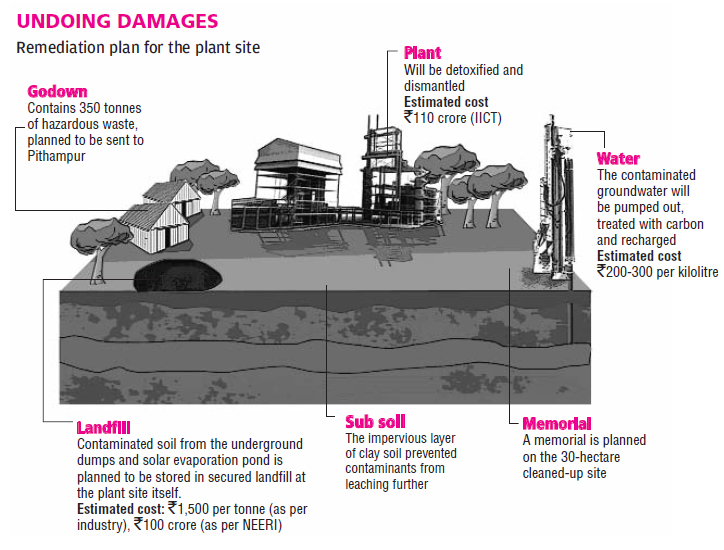 Immediate measures, for actions within six months:
Immediate measures, for actions within six months:
● Securing the site and preventing annual surface water runoff
i) Fencing and guarding of the UCIL site and landfill area within SEP
ii) Stopping construction at the SEP area
iii) Measures to protect annual surface water runoff from the site during monsoon
● Excavation, recovery and characterisation of waste dumped at the UCIL site
i) Clearing vegetation and dewatering the site
ii) Identification and refurbishment of a temporary storage area for excavated waste
iii) Recovery of dump materials from already identified and new sites
iv) Recovery of mercury in drains, pan filters and soil with local community help
v) Inventorisation of the collected waste for treatment and/or disposal six months
● Characterisation and incineration of the stored waste at the UCIL site
i) Trial at Pithampur incinerator with 10 tonnes of similar waste from Hindustan Insecticide Limited, Kerala
ii) Characterisation results of the stored UCIL waste to be made public; if required,further characterisation and inventorisation to be done along with the trials
iii) Waste with high calorific value and hazardous in nature to be incinerated with continuous stack monitoring; remaining waste to be dealt with suitable decontamination/remediation measures Medium- and long-term measures:
● Groundwater contamination assessment and remediation outside UCIL site
i) Field investigation and lab analysis of the groundwater
ii) Possibility of hydraulic containment to be explored as an interim measure
iii) Remediation/containment plan to be developed and implemented
● Characterisation and remediation of waste in Solar Evaporation Plant
i) Development of a basket of disposal/ decontamination /remediation options
ii) Disposal/remediation of the waste and decontamination of the landfill area
● Remediation of entire solar evaporation plant area
i) Assessment of geohydrology and contamination based on previous reports
ii) Development and implementation of the remediation plan keeping residential purpose in mind in three to five years
● Detoxificaion, dismantling and decommissioning of UCIL premises
i) MIC plant including the vent, vent scrubber, storage tanks and control room to be strengthened and preserved
ii) Remaining parts of the site to be decontaminated, dismantled and decommissioned as recommended by IICT
● Remediation and fate of the UCIL site
i) Geohydrological and contamination studies for the site based on stratified judgemental sampling
ii) Development of a basket of decontamination/disposal methods accordingly
iii) Remediation plan based on future use as a memorial and a centre of excellence
iv) An international competition on master planning for conversion of the site
v) Implementation of the remediation plan and conversion of the site to a memorial and a centre of excellence
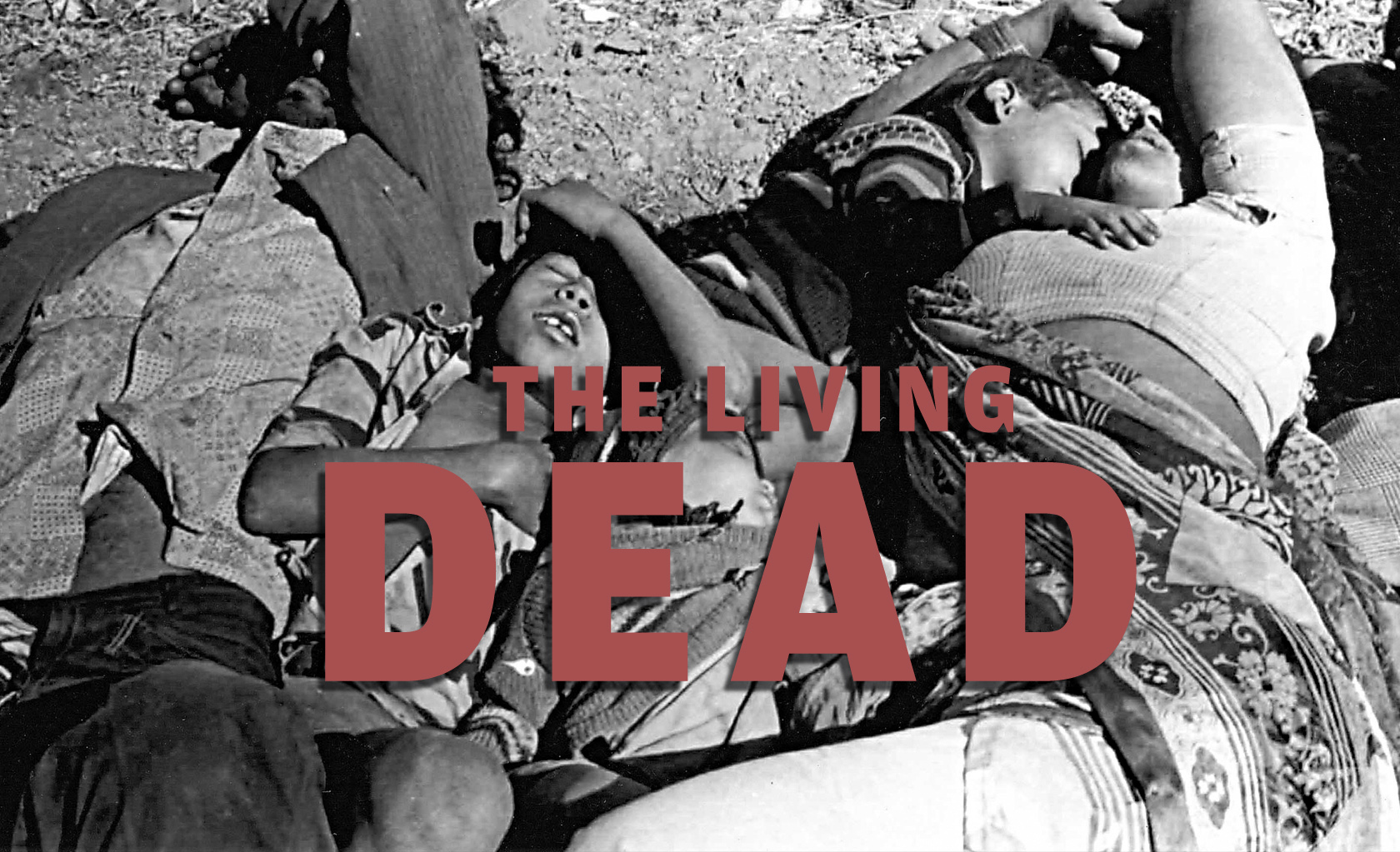
This is because while on court’s prompting, the Madhya Pradesh government setup hospitals with modern equipments in the city, it has not arranged for specialist doctors. Research projects that were promptly initiated to underst and the health impacts of the gas leak were abandoned within 10 years without a plausible explanation. For long after that, independent studies and doctors continued to highlight high incidence of lung cancer, adverse outcomes of pregnancy and respiratory, neurological, psychiatric and ophthalmic problems among those exposedto the gas. No consolidated record exists to show how many people are still suffering. As a result, even after the government paid compensation, however little, to more than half a million victims, fresh claims are still pouring in.
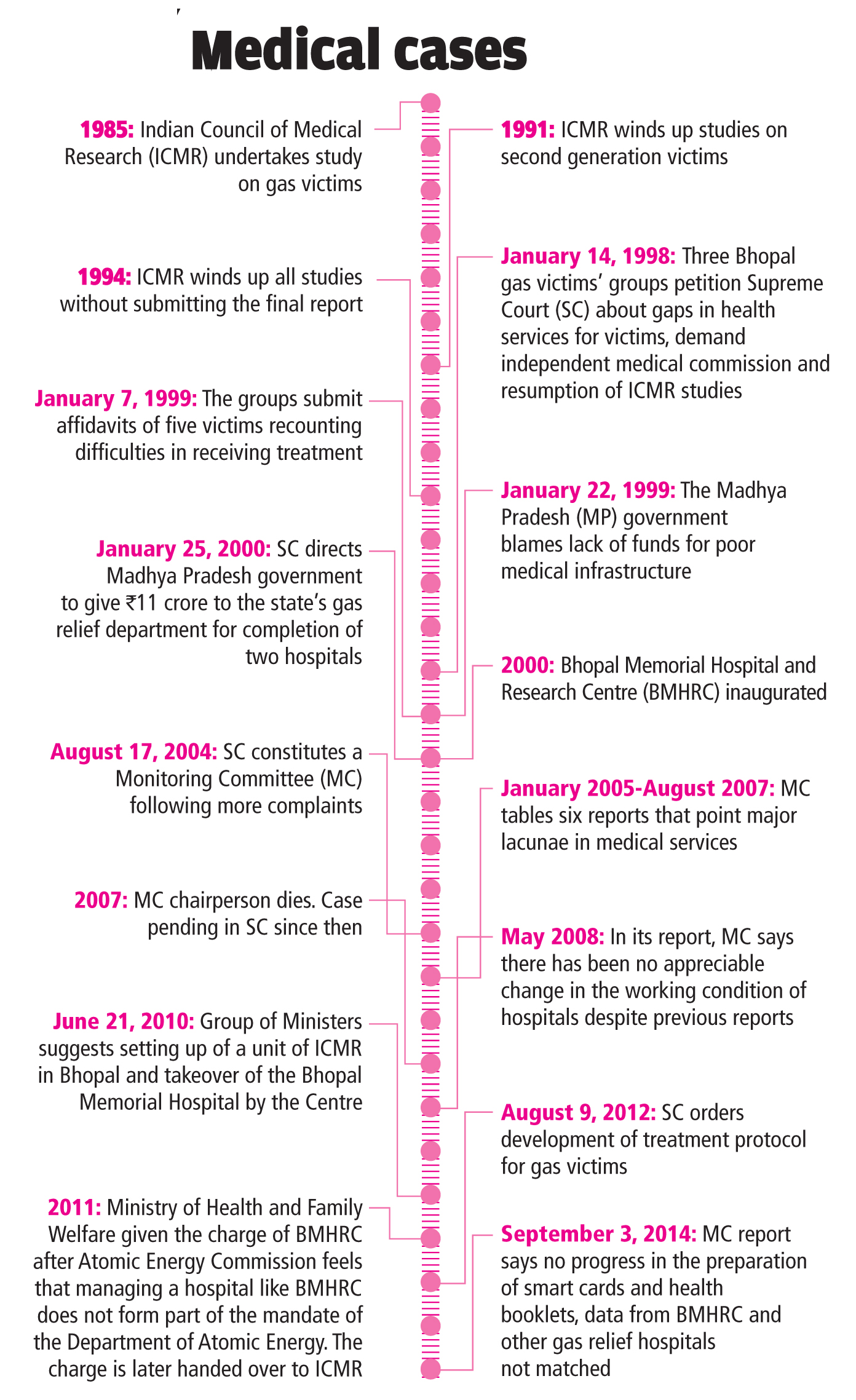
Treatment for unknown
Something as basic as the understanding of the chemicals people were exposed to on that fateful night on December 2, 1984, and their impacts on human body is missing—even 30 years after hundreds of thousands of people inhaled a cocktail of unknown and deadly gases. That night water had entered the methyl isocyanate (MIC) plant at the Union Carbide factory.
The reaction between MIC and water was unknown. A committee set up soon after the accident to study its scientific and technical aspects conducted a series of studies to understand the chemical behavior of MIC. The team led by the committee head, S Varadarajan, identified 12 break down products of MIC but the exact composition of the gas, which brought about the diseases is not known. Another study puts down this number at around 21.
Research initiated, abandoned
In 1985, ICMR began studying the health impact of the gas exposure. It initiated 24 long-term projects. The results of ICMR studies could have strengthened the case against Union Carbide for compensation but the data was never used in court, norwere the findings made public.
Chromosomal abnormalities were noted in the early acute phase. Abortions were more frequent and intrauterine growth was retarded in babies born to exposed mothers. It is clear that the monitoring of ill-effects and care of the afflicted have tobe carried out for years, the report said.
But ICMR had already terminated nearly all the projects by then.
Cancer cases have increased in Bhopal. The authorities attribute it to tobacco consumption but a section of activists and doctors who have been working in the city for long suspect it is the result of gas exposure.
The latest data from the Bhopal cancer registry, set up after the disaster, shows that cancer cases have increased 3.4 times among men and 2.5 times in women between 1988 and 2007. The study compared cancer incidence in the MIC-affected and unaffected areas. It found that in affected areas, 89.56 women per 100,000 women were suffering from cancer in 1988 which increased to 192.39 in 2007. In unaffected areas, 95.95 women per 100,000 were suffering from cancer in 1988 compared to 174.97 in 2007.

Hospitals without doctors
Poor quality of medical care is an old complaint. In the name of medical rehabilitation, the emphasis has been on creating infrastructure. By 1996, the number of beds in Bhopal was nearly twice the number of beds recommended by the World Health Organization but the government insisted on increasing the infrastructure. In 1998, the Supreme Court directed setting up of BMHRC for providing healthcare to the gas-affected population and the Bhopal Memorial Hospital Trust to run the hospital. The hospital was built from the sale of UCIL shares. A corpus was created, which in 2012 stood at Rs 436.47 crore. This has not helped much.
The absence of specialists in the hospital also finds a mention in a report submitted in 2014 by the monitoring committee constituted by the Supreme Court in 2004. The monitoring committee reviews healthcare facilities for gas victims in the city and is supposed to prepare a report every three months.
Records in disarray
The authorities use all sorts of tactics to avoid accountability. Something as basic as computerisation of patients’ health records has failed. In 2004, the Supreme Court directed Madhya Pradesh to computerise the records of the hospital to facilitate the treatment of gas victims. Computerisation was required for coordination within the hospitals and between different hospitals of the Gas Relief Department.
The Supreme Court, in September 2013, directed the National Informatics Centre—which is under the Union Ministry of Communications and Information Technology— to computerise the medical records of gas victims.
Missing evidence
Questions are being raised about the authenticity of forensic samples of Bhopal gas victims
To make matters worse, the authorities have no forensic evidence of the disaster. It would have proved to be the most crucial evidence in the ongoing trials and would have also helped understand the ill-effects of methyl isocyanate (MIC)—the poisonous gas that leaked from the Union Carbide pesticide plant in Bhopal and killed thousands on the intervening night of December 2-3,1984. Shockingly, most “samples” that are available, such aspreserved foetuses that became the cover photographs of magazines, might not be those of the tragedy victims. “There is not a single sample in our institute which we can say for sure belongs to the gas victims,”says D S Badkur, director of Medico-Legal Institute (MLI) in Bhopal.
Ever diminishing compensation
In September 2014, survivors of the Bhopal gas disaster and residents of colonies located near the closed Union Carbide plant chained them selves to the gate of the state chief minister’s residence. Several protesters lay on the road, covering their body with white sheets. “We are dying every day. The burden of diseases is too heavy to bearand our government has sold us,” said Shakuntala Mangilal Khatik.
For the three decades that followed, the issue of compensation has remained asore point. Initially, the Indian government had demanded US $3.5 billion as compensation. With the passage of time it seemed eager to climb down from its stand. As more time passed and the case got bogged down in litigation, the government looked ready to collect what ever loose change was thrown its way.
In 1989, UCC parted happily with $470—about one-seventh of the amount originally asked for—as the final settlement. The Supreme Court, guardian of the money now stashed away in a Reserve Bank of India account, issued guidelines for the money to be handed over to people. Next of kin of the dead were to be given Rs 1-3 lakh (this was later increased to a maximum of Rs 5 lakh); fully or partially disabled were to receive Rs 50,000-2 lakh. For temporary injury, the apex court earmarkedRs 25,000-1 lakh each. The state government then conveniently picked thelower limit and froze compensation at that level: Rs 25,000 for injury and Rs 1 lakh for death. It ignored that the court had mentioned a range, no doubt to be decided on acase-to-case basis.
In 1989, the money UCC gave was worth Rs 750 crore in Indian currency. Then,the rupee devalued and the value of the amount swelled to about Rs 3,000 crore. So, how has the government spent the money? This is where the scam deepens. In 1989, when th ecase was decided, the government had said that there were some 3,000 cases of death and 30,000 cases of permanent injury. But it doled out compensation to virtually the entire city—573,588 people got money as “affected” by the gas leakage. Of these, 5,295 were death cases, whose families got a paltry Rs 2-3 lakh as compensation. The rest, 568,293, were classified as injury cases. The government deducted from the settlement amount what it had paid over six years as interim relief, so the final compensation was grossly negligible—less than Rs 15,000 per person on average.
Game of relief
Relief became a game between the Centre and the state. In 1985 the Centre, responsible for finances, provided the state Rs 102 crore for rehabilitation work. It provided another Rs 163.10 crore in 1992 for medical rehabilitation over the next five years. But nothing moved on the ground.
In July 1999, the Centre decided it would no longer fund the state government efforts to help the victims. Madhya Pradesh had to find money for itself and was put in sole charge of the rehabilitation initiative.
A further sum of Rs 1,509 crore has been paid as pro-rata compensation to people who had been compensated in the first round. Now there is no money left to distribute.
In December, 2010, the Union of India filed a curative petition in the Supreme Court for additional compensation from Union Carbide and Dow Chemical Company, which has acquired UCC. The petition asks for Rs 315.7 crore on account of remedial measures to be undertaken for environmental degradation, Rs 1,743.15 crore on account of actual expenditure incurred/ committed by the Central/state governments towards relief and rehabilitation measures, and a sum between $629 million and $1.2 billion as additional compensation for people who had not been included in the settlement of 1989. Legal experts say this might be to pacify the victims who are demanding higher compensation and if UCC refuses to pay up, the Indian government is likely to use this as an excuse for not paying higher compensation. In December 2011, the company filed an affidavit in the court and rejected the Indian government’s claims. The company said it had given the money for compensation more than four years after the accident, and that this period provided the government sufficient time to assess the damage.
In the affidavit, UCC also pointed out that the issue of compensation had been raised twice earlier and the court had ruled in favour of the company. “Nothing has changed since the last time the court rejected the allegations in 2007.
The case continues but the victims feel short-changed even in this curative petition. The death figure given in the curative petition is at odds with that in the Madhya Pradesh government’s Action Plan of 2008. The state figure is 16,000 while the curative petition puts it at 5,295. However, the state’s minister for Bhopal gas tragedy relief and rehabilitation, a permanent invitee to the Group of Ministers on Bhopal, chose to go with the decision of the Group of Ministers. The official figures of the extent of injuries caused by the disaster are also different from those presented in the curative petition. Records from the hospitals run by the Department of Bhopal Gas Tragedy Relief and Rehabilitation show that there were 502,686 persons with chronic illnesses 18 years after the disaster. According to the survivors’ petition, the Indian government should claim at least $8.1 billion, which is about seven times the amount it is claiming.
Disturbing rehabilitation
The relief provided to the people affected by the chemicals could not take care of the needs of their life time. 50,000 people who needed occupational rehab, only about 100 got any help. According to the website of the Bhopal Gas Tragedy Relief and Rehabilitation Department, till March 2009, the department had spent Rs 27.06 crore.
The promise of housing was equally deluding. A total of 2,486 houses have been constructed and distributed to the widows of those who died in the gas disaster. The houses in this widow colony, named Jivan Jyoti Colony, do not have adequate water or electricity supply. The colony is not connected by public transport, does not have health centres, banks and even schools.
The government’s reputation in relocation is poor. In 2007, the government relocated more than 150 families from New Arif Nagar, a colony close to the factory, to Parwakheda, 15-20 km from the city. The people were moved without any arrangements being made at the new location. They were given Rs 1,900 and two bamboo sticks to set up a tent. There is no facility in the area. The “rehabilitated” people say they approached several government officials and agencies but received nohelp. Says 35-year-old Ramcharan Ahirwar: “Our lives are miserable due to diseases. Earlier, we were at least near hospitals but now getting treatment is a challenge.”
A mix of government in sincerity, procedural delays and legal loop holes has ensured that those responsible for India’s first major industrial disaster have got off the hook. This also means that victims have not been compensated fairly

In the past 10 years, toxic waste in and around the factory has come under public scrutiny. But decontamination is not high on official agenda
In November 12, 2014, the Dow Chemical Company failed to comply with summons issued by the Chief Judicial Magistrate (CJM) of Bhopal on a criminal complaint filed in connection with the 1984 tragedy. The court directed the company to appear before it to explain why it has not produced its wholly-owned subsidiary, Union Carbide Corporation (UCC), before the court. The summons issued on August 4, 2014, madeit clear that, as UCC’s sole owner, Dow has a responsibility to ensure UCC faces these charges. It directed Dow to appear before the court on November 12.
The non-profit Bhopal Group for Information and Action (BGIA), had filed an application in the court on February 26, 2004, seeking explanation from Dow Chemical on why it could not compel its 100 per cent subsidiary to appear before court.
The summons issued in August were the second to be issued to Dow this year. Another summon issued to the company in February 2014 was ignored by Dow on the pre text that the Indian government had not followed proper procedure.
Dilution of charges
Some definitive moments in the long and complex court cases related to the disaster came in 2010. On June 7 that year the chief judicial magistrate (CJM) of Bhopal sentenced Keshub Mahindra, who headed Union Carbide India Limited (UCIL)— the Indian subsidiary of UCC—at the time of the tragedy and six other employees of the company. The first verdict handing out convictions, it ordered two years in jail and a fine of Rs 1 lakh each. It took 14 years for the court to give this verdict. But the seven were out on a personal bond of Rs 25,000 within hours of the verdict. Another accused, R B Roy Choudhary, the assistant works manager of UCIL, Mumbai at the time of the tragedy, had died during the course of the trial.
A petition for review of charges filed in April 2010 by organisations intervening in the case—Bhopal Gas Peedit Sangharsh Sahayog Samiti (BGPSSS) and Bhopal Gas Peedit Mahila Udyog Sangathan (BGPMUS)—could have opened possibilities for severe sentences. The petition filed under Section 216 of the Criminal Procedure Code(CrPC) sought enhancement of charges based on the submission made by 178 prosecution witnesses. Article 216 of the CrPC empowers any court to alter or add toany charge at any time before judgement is pronounced. “The latest submissions were sufficient to enhance the charges. But the CJM Mohan Tiwari dismissed the petition,”said N D Jayprakash, convenor of BGPSSS. Supreme Court advocate Rajeev Dhavan believes that the CJM could have told theprosecution to approach the apex court. “It would be a big call for a CJM to go against the apex court and alter the 1996 charges,” he said.
What was ignored in 1996
The plant in Bhopal was the only one in the world which had MIC storage as part ofits design. To cut costs the staff was reduced some time before the accident, the nitrogen pressure in the MIC tanks was reduced (the pressure kept the gas under control), andthe alarm system was shut down. There were enough warnings of theimpending disaster—newspaper articles, a legal notice to UCIL, a UCC audit report that talked of 30 major hazards, of which 11 were in the MIC and phosgene units of the Bhopal plant.
Most of these facts were placed before the Supreme Court in 1996, when chief justice A M Ahmadi and S B Majumdar diluted the charges, citing lack of prima facie evidence that the accused operated the Bhopal plant on the night of the accident “with the knowledge that such runningof the plant was likely to cause death”. “There was enough evidence in documents seized from the company. Even now Ahmadi has not been able to give a good reason for diluting the charges,” said K Madhavan,former joint director of CBI who was a DIG in charge of the Bhopal case till 1988. The Bhopal case received the biggest blow in 1989 when the apex court agreed to a one-time settlement of US $470 million and quashed criminal charges.
Leading up to 1996
The criminal case was originally filed in 1987 in the CJM’S court. The 12 accused included UCC, UCE Hong Kong, UCIL and top officials of the three companies. They faced the charge of culpable homicide not amounting to murder that was punishable with up to 10 years’ imprisonment.
On July 6, 1988, the CJM sent a Letter Rogatory to the US government to permit CBI to carry out a comparative study of the safety systems of the MIC units of UCC’s Bhopal and West Virginia plants to verify whether UCC had installed inferior safety systems atits Bhopal plant. On February 9, 1989, the CJM also issued a non-bailable warrant ofarrest against Anderson, accused No 1 in the criminal case. Five days later on February 14, 1989, the US Justice Department informed the Indian Embassy in Washington that the permission had been granted to the CBI to inspect UCC’s West Virginia plant for comparing safety standards.
BGPMUS and the Bhopal Gas Peedith Sangharsh Sahayog Samiti (BGPSSS) intervenedand the termination of criminal cases against all the accused was revoked, with theSupreme Court reinstating the case on October 3, 1991. In April 1993, the Sessions Court, Bhopal, framed charges of culpable homicide and other offences against all the Indian accused who were appearing before the court. But an appeal by the accused the Supreme Court in 1996 led to the dilution of charges against them from culpable homicide not amounting to murder (Section 304 Part II of the Indian Penal code, or IPC) to causing death due to negligence (Section 304 A).
Death and peanuts
Union Carbide has used the same evasive tactics in the civil cases against it. In March 1985, through the Bhopal Gas Leak Disaster (Processing of Claims) Act, the Indian government arrogated to itself the sole power to represent the victims in the civillitigation against Union Carbide. It then filed a $3 billion compensation suit on behalf of the victims in New York district court but the case was sent to Indian courts in May 1986, with the condition that Union Carbide would submit to the jurisdiction of Indian courts.
Union Carbide’s lawyers devised a plan to delay all legal proceedings in order to squeeze the Indian government into accepting a low settlement. It contested the jurisdiction of courts it sought to be tried before. It pleaded to have “illiterate” victims’claims denied. It threatened to summon every individual survivor and appeal allIndian decisions in US courts. It denied it was a multinational. It claimed the gas wasnot ultra-hazardous. It blamed an unnamed saboteur. It appealed court orders for humanitarian relief, while professing its concern for the victims. Their first settlement offer was a paltry $100 million dollars, less than half the company’s liability insurance cover that time. By 1989, UCC had spent at least $50 million on legal fees alone.
Supreme Court
i. Writ Petition (Civil) No.50 of 1998 (was filed by BGPMUS, BGIA and BGPSSS on 14.01.1998 for providing proper medical relief to gas-victims & maintaining their complete health records). The matter has been transferred to the MP High Court at Jabalpur for monitoring the execution of the directions of the Supreme Court’s Order dated 09.08.2012.
ii. Special Leave Petition (Civil) No.12893 of 2010 (filed by members of BGPMUS & BGPSSS on 17.03.2010 for enhancement of compensation to gas-victims in terms of the actual magnitude/ grievous effects of the disaster);
iii. Curative Petition (Civil) Nos.345-347 of 2010 (was filed bythe Union of India [UOI] on 03.12.2010 for enhancement of compensation to gas-victims by partially challenging the basis of the Bhopal Settlement of 1989.) BGPMUS & BGPSSS have filed an inter locutory application on 24.10.2013, challenging UoI’s low estimation of the number of dead & seriously injured gas-victims.
iv. Transfer Petition (Civil) No.170 of 2011 (filed by UoI in January 2011 for transferring W.P.[C] No.2802 of 2004 from the MP High Court to the Supreme Court);
v. SLP (C) No. 9874 of 2012 (filed by the UoI in March 2012 to seek permission to dispose of 345 tonnes of toxic waste currently stored on the site of the former UCIL plant at an incineration facility near Indore). BGPMUS & BGPSSS have filed an interlocutory application in the same on 24.01.2013 to point out that not only are the incinerators in the country of poor quality but also that the magnitude & complexities of the problem of UCIL’s toxic waste have neither been properly assessed norcorrect methods for their safe disposal been formulated.
vi. W.P. (C) No.657/1995 (filed by Research Foundation for Science, Technology and Natural Resource Policy, Dehradun, against import of hazardous waste–and related issues–in which provision of safe drinking water to residents in and around the Bhopal plant, where ground water is contaminated, has fallen within its ambit)
vii. W.P. (C) No.33 of 2012 (filed by Swasthya Adhikar Manch,Indore, in January 2012 to expose malpractices of pharmaceutical companies as well as independent investigators in conducting clinical trials across the country). BGPMUS & BGPSSS filed an interlocutory application in the same on 14.12.2012 for unraveling the truth behind the secret drug trials conducted at the Bhopal Memorial Hospital & Research Centre (BMHRC) during2004-2008, inwhich gas-victims were used as guinea pigs, and urging prosecution of the guilty.
Madhya Pradesh High Court (Jabalpur)
i. W.P.(C) No.2802 of 2004 (a public interest litigation–for remediation of the contaminated soil and ground water in and around the Union Carbide plant in Bhopal–in which BGPMUS & BGPSSS are interveners). The matter is in the process of being transferred to the Supreme Court.
ii. W.P. (C) No.15658 of 2012 (re-numbered version of W.P.[C] No. 50 of 1998 after the Supreme Court transferred it to the M P High Court for monitoring the execution of the Supreme Court’s directions dated 09.08.2012).
iii. BGPMUS & BGPSSS are in the process of filing a Writ Petition seeking speedy disposal of the criminal cases against the accused in the Bhopal Gas Leak Disaster case.The said Writ Petition would also seek appropriate remedy against the dismissal by the Sessions Court,Bhopal, of the Criminal Revision Applications filed by BGPSSS & BGPMUS, by the CBI, and by the State of Madhya Pradesh, which opposed reduction of charges against accused Nos.2 to 9 & 12 by the CJM, Bhopal,vide Judgment dated 07.06.2010.
District Sessions Court, Bhopal
i. Criminal Appeals filed by accused Nos. 2 to 9 & 12 for dismissing the Judgement & Order of the CJM,Bhopal, dated 07.06.2010
ii. Criminal Case No.8460 of 1996 is currently pending before the Sessions Court. The Sessions Court has rejected the Criminal Revision
iii. Applications filed by the Madhya Pradesh Government, by BGPSSS & BGPMUS, and by the CBI seeking enhancement of charges against the said accused.
Court of the chief Judicial Magistrate, Bhopal
i. Miscellaneous Judicial Case (MJC) No.91 of 1992 (criminal case against absconding accused Nos.1, 10 and 11, i.e., Warren Anderson; UCC and its successor, Dow Chemical Company, USA; and Union Carbide Eastern, Hong Kong,is pending before the Court. The Union of India has not yet executed the non-bailable warrant of arrest issued by the CJM, Bhopal, on 27.03.1992 against Anderson.
ii. Based on the application filed by BGPSSS, BGIA and BGPMUS on 07.09.2001, CJM on 06.01.2005 issued notice to Dow Chemical, USA, to appear in the criminal case on behalf of accused No.10 (UCC, USA). The same was stayedby the MP High Court at Jabalpur vide order dated 17.03.2005, on the basis of an application filed by Dow Chemical International Private Ltd (DCIPL), Mumbai, which purportedly had no direct nexus with Dow Chemical, USA. After the MP High Court vacated the said stay-order after a 7-year delay vide Order dated 19.10.2012, the said notice was re-issued by the CJM on24.07.2013. Dow is yet to respond to the notice.
Million mini Bhopals
Thirty one years of official in sincerity means other industrial disasters loom
Sunita Narain & Chandra Bhushan
The Bhopal gas leak was India's first major industrial disaster. Till then, governments in the country had handled floods, cyclones and earthquakes. They had no clue how to respond to this catastrophe. Multinational company Union Carbide Corporation (UCC), which owned the Bhopal plant through its subsidiary UCIL, did little to help deal with the human tragedy. Thirty one years later, there is no closure. Not because of what happened that fateful night, but because our response has been in competent and callous. Bhopal was struck by two tragedies: one that happened immediately, and the other that unfolded in the years to come.The problem was nobody knew much about the toxin or itsantidote.
Related
News: German company penalised for ‘Bhopal sister’ plant accident in US
With in weeks of the accident many claimed that the worstwas over—that the people were suffering from common ailments of the poor, such as tuberculosis and anaemia. But till date no body knows the health impacts of methyl isocyanate (MIC)and ways to treat patients exposed to the gas. The health burdenis compounded by two more variables—one, children born after the disaster are also its victims because of exposure to the deadly gas while they were in their mothers’ wombs; two, chemical wastes remain dumped in and around the UCIL factory, contaminating the water that people drink.
The diseases could also have been managed had the government conducted medical research to understand the long-term impacts of the gas. The responsibility was given to ICMR. Some of its studies found high incidence of lung and eye diseases in the victims. But the studies by ICMR were summarily discontinued in 1994. Some independent studies also pointed to serious health crisis, from cancer and mental problems to birth defects. But since there is no epidemiological study, it is easy to dismiss the crisis as ailments caused by poverty and lack of hygiene. This is when the Supreme Court has repeatedly asked for such studies. An even larger number of people are threatened by the waste still lying in and around the factory, polluting the soil and groundwater. Many of the chemicals dumped there degrade slowly and are likely to remain in the environment for hundreds of years. Dow Chemical, which has acquired UCC, denies the liability to clean it up. The worst part is that cleaning and decontamination of the site have got embroiled in legal wrangle over how to clean the site, what should be done withthe waste and who should pay for it?
Why no Closure
Everything that could have gone wrong in the initial years after the tragedy went wrong. After this, all that the people and activists have doneis try and reverse those fatally damaging actions with little success. The Indian judiciary blundered, many would say, by agreeing to a paltry compensation and settling all civil and criminal liability of the company. Then, the company did everything to ensure that its complicity and responsibility was diluted. ICMR failed the victims by not completing the studies that would have established the cause of their ailments and suggesting treatment protocols. So, there is a name for the disease—Bhopal gas disease—but no identification of who the affected are or what their treatment status is. The Union government, as a result, continues to argue that only 5,295 people died—in the first instance and never later—and 6,199 have been permanently disabled. It refuses to accept, without medical history, that the tragedy has been much more enormous. The state government dashed remaining hopes by distributing the compensation amount so widely that it does not matter who is the actual victim and who is not.
But there are more reasons for the failure. First, there are too many institutions involved, and they have little interest in fixing the problem. In the case of medical relief, on paper, every step has been taken to ensure that people get timely and best treatment. A super-speciality hospital has been set up. Treatment has been assured without payment. The Supreme Court even set up two committees—one to monitor the functioning of the medical system and the other to advise on what needs to bed one for the best care of the victims.
There is a task force for removal of toxic waste from the plant, headed by the secretary ofthe department of chemicals and petrochemicals at the Centre. An Oversight Committee is coordinating and monitoring activities relating to waste disposal, decontamination and remediation. The minister of state for environment chairs this committee. At the bottom of the rung are pollution control boards that are supposed to monitor the site and provide technical support for the decontamination work.
The institutional logjam is such that there isno one institution that can be held responsible and accountable for decontaminating the site.
Secondly, over time, most residents of the city havemoved away and beyond the disaster. Civil society groups that remain are intensely committed and driven by the sense of injustice. But there is suchdeep distrust between the government and the activists working in Bhopal that every action proposed is obstructed, mainly by taking the matter to court. As the interest of the national and international media remains high in the case, each incident is played up and charges and counter-charges are made on television and in newspapers. The result is everything has been left to the courts to decide; the state and the Central agencies have taken the back seat.
After the historical 1989 decision absolving UCC of corporate criminal liability, the courts have given directions on relief and rehabilitation. But in the polarised environment, even their directions have come tonaught. This is partly because there is no clarity on what needs to be done and what can be done. It is a stark fact that Indian institutions are incapable of resolving conflicts. But there is learning for activists and non-profits. The fight should not become anend in itself, keeping issues unresolved.
Impact on legislation
The first major piece of legislation inIndia that came post-Bhopal was the Environment (Protection) Act (EPA) of1986. “EPA bears the stamp of the legislature’s immediate concern after Bhopal to strengthen the regulatory framework for hazardous industry and pollution control. EPA is India’s first piece of legislation that gave authority to the Centre to issue direct orders to close, prohibit or regulate any industry. It is also an enabling law, which delegates wide powers to the executive, allowing it to make rules to manage different issues.
By 1989, the country got the Hazardous Waste (Management and Handling) Rules for management, storage and import of hazardous chemicals. Even the coastal areas are protected under EPA through its subordinate rules. In 1987, amendments were made in the Factories Act, which empowers states to appoint site appraisal committees to advise on the location of factories using hazardous processes. It also sets up systems for the safety of workers and residents nearby and specifies emergency disaster control plans. In 1991, the Public Liability Insurance Act was enacted to provide immediate relief to persons affected by accidents while handling hazardous substances.
Despite these pieces of legislation in place, India is fast losing the battle of environmental protection and management of hazardous waste. The total dead and injured in 2011 were 10,441. That year, over 1,000 people lost their lives in factory accidents. It is not surprising that the states with the worst worker safety records were the industrialised Andhra Pradesh, Maharashtra and Gujarat. Gujarat was the worst, with closeto 250 dead and 3,000 injured. A review of newspaper reports shows that in just 10 months of 2014 eight industrial incidents took place, where workers died or were hospitalised. Many more cases would havegone unreported.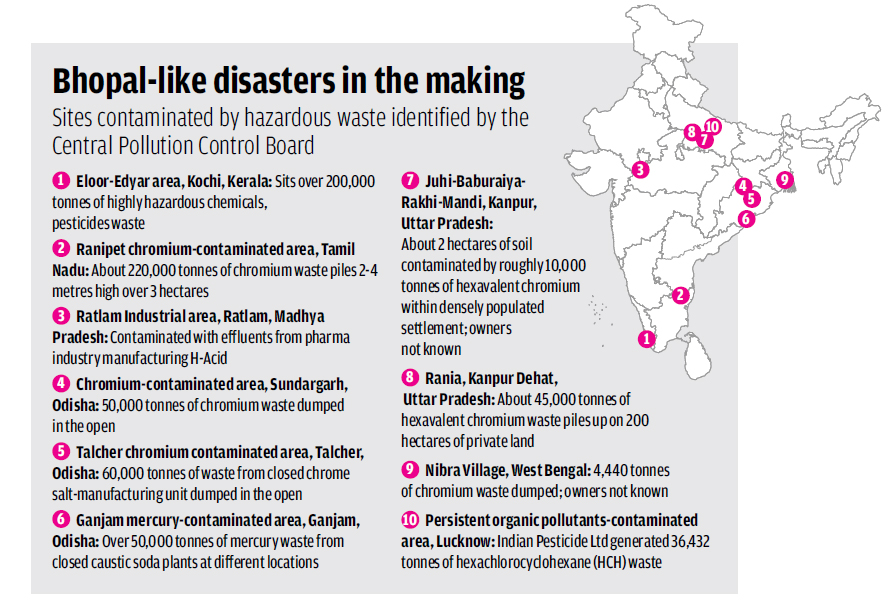 In 2010, the Union Ministry of Environment and Forests (MoEF) launched a project for remediation of sites contaminated by hazardous waste with much fanfare. A total of 10 toxic sites were identified.
In 2010, the Union Ministry of Environment and Forests (MoEF) launched a project for remediation of sites contaminated by hazardous waste with much fanfare. A total of 10 toxic sites were identified.
Agenda after 30 years
Analysis shows that on an average a state pollution board collects about one water sample per factory and surveys less than 25 per cent of the units for air quality. In fact, the entire environmental monitoring depends on self-reporting by industries, which are required to get samples of effluents tested in private laboratories and submit the data to the pollution board. It is another matter that the laboratories are, in manycases, extremely inadequate and unskilled. It is yet another matter that the pollution board officials do not even have the time to look at the reports. It is about paperwork, not about controlling pollution. It is not about enforcement.
Sunita Narain, Director General Centre For Science and Environment, New Delhi talks about the lessons learnt from the Bhopal Gas disaster
Disable background sound
The system provides no deterrence. The maximum penalty imposed by courts under the Water (Prevention and Control of Pollution) Act is Rs 10,000 and under EPA is Rs 1 lakh. But only courts can impose this penalty. So all that the boards can do isto either deny the consent to operate or issue closure notice for 30 days. Both options are not feasible. So, very little action is taken against the polluter.
Forest clearance is an even bigger paper tiger. Ninety-four per cent of the projects are cleared with an assessment of their impact on forest, biodiversity and livelihoods of those who live in these habitats. Then, it is stipulated that compensatory afforestation will be done for each hectare of forest diverted. But nobody really knows if the trees are even planted, let alone if they survive. The system continues with this farce of taking action as if laws and processes are enough to make a difference. This can be fixed. Changing this requires strengthening institutions. This is the agenda for environmental governance 30 years after Bhopal.
The last, but most critical, agenda after 31 years of Bhopal is to do everything that increases the participation of local people, worst impacted by environmental degradation and pollution, in governance. This can be done through more transparent public hearings, more public data dissemination and more avenues for hearing people out. The bottom line is that India’s environmental management system is a job half done. It should be finished so that we can meet the challenges of sustainable and inclusive growth. Only then will we really learn the lessons of the world’s most horrific industrial disaster.
Liablity cannot be forgotten
After 31 years the government of India is still struggling to establish the liability of UCIL, its parent company UCC and its buyer, Dow Chemical. It is a shame. Consider the difference. In 2009, when petroleum giant BP’s oil drilling led to a devastating spill in the Gulf of Mexico, the US President Barack Obama did not need to ask whose “ass he should kick”. His government held those responsible to pay for the damage and reversed the earlier decision to cap liability in such cases. It established criminal liability to people and the environment. In 1989, when Exxon Valdex spilled gallons of oil off the coast of Alaska in the US, the compensation for economic loss and punitive damages was fixed at some US $1 billion, as against the Bhopal “relief” of US $470 million. The dead seals of the Atlantic were valued higher than the thousands of humans who lost their lives in Bhopal and continue to suffer even today.
In 2009, when petroleum giant BP’s oil drilling led to a devastating spill in the Gulf of Mexico, the US President Barack Obama did not need to ask whose “ass he should kick”. His government held those responsible to pay for the damage and reversed the earlier decision to cap liability in such cases. It established criminal liability to people and the environment. In 1989, when Exxon Valdex spilled gallons of oil off the coast of Alaska in the US, the compensation for economic loss and punitive damages was fixed at some US $1 billion, as against the Bhopal “relief” of US $470 million.
In Bhopal, the US multinational company UCC argued sabotage. The Indian government could not (or would not) prove negligence or regulatory failure or even lack of responsible adherence to internal safety standards. The liability was never established, partly because of ignorance, combined with power lessness. Today, when the government is faced with the cost of remediation of toxic waste—left behind by the company—it is still not able to establish the liability of the company.
The courts have also been vacillating on this issue. As legal scholars Divan and Rosencranz explain, the Supreme Court replaced the traditional doctrine of liability with the rule of “absolute” liability. In the Shriram gas leak case, decided by theSupreme Court in 1986, the then chief justice P N Bhagwati observed that the principles and norms for determining the liability of large enterprises engaged in the manufacture and sale of hazardous products were questions of greatest importance.
So, in its judgment the Supreme Court Bench established that the “enterprise owes an absolute and non-delegable duty to the community to ensure that no harm results to anyone on account of hazardous or inherently dangerous nature of the activity which it has undertaken”. The justices go on to say, “We would hold that enterprise strictly and absolutely liable to compensate all those who are affected by the accident and such liability is not subject to any of the exceptions which operate vis-à-vis the tortuous principle of strict liability under the rule in Rylands v Fletcher.”
Under this rule, strict liability is subject to a number of exceptions, like sabotage or the plaintiff’s own fault, which reduce its scope. This principle was applied by the Madhya Pradesh High Court to support its award of interim compensation to Bhopal gas leak victims. The court ruled that the liability of the enterprise is “unquestionable”.
Blog: The Bhopal in us
More importantly, the issue of corporate liability is crucial, foronly then will powerful companies worry about the implications of their actions on tomorrow’s generations. Today, they think of short-term and run away profits—in chemicals, GM foods, nuclear energy or mining and drilling. We need tough corporate liability so that companies think twice before they expose us to dangers. Let them fret; we want to sleep in peace.This is why Bhopal must never befor gotten, indeed it must be fixed. Dow Chemical must be held liable for the toxic waste still present in the abandonedfactory. It must pay for the plant site’s remediation. It must do this quickly, before toxins spread more poison, travelling through groundwater, into people’s bodies. This is alsowhy Bhopal is not just about Bhopal, but about our collective action to bring justice to the people and do right to the environment across the world.
Data Courtesy: Centre for Science and Environment
See complete Report
Bhopal gas tragedy: After 30 years
